Separate and distinct images and meditations for each single prayer in The Chaplet of the Divine Mercy. Background music masterworks in separate settings of the ancient hymn Ave Verum Corpus, “Hail True Body” (Pope Innocent VI).
This page is a mockup for a video of The Chaplet of the Divine Mercy currently under development. The video’s elements are in three layers.
The images with captions constitute a front layer. The images were originally developed as slides; in some instances there is excessive “white-space” at the bottom of the images. Please scan past the white-space and continue praying.
For the middle layer, praying out-loud the prayers displayed on the images, which you can do while scanning through each image in a series while each section’s background music is playing, is part of a testing process to eventually set up narration tempo (how fast the prayers are read), to be incorporated in the final video.
The back layer is the music audio tracks. Their length will be carefully balanced with the tempo of the narration; some notes may have to be cut or added to coordinate with the prayer sections. (In Windows, the music can be halted by touching the spacebar.)
You can help develop this project by praying the prayers and commenting the experience.
All seven of the background music selections are historic masterworks of the common practice period (1450-1950) based upon the text of the Gregorian Plainchant hymn “Ave Verum Corpus”, Hail True Body.
To audition the core thematic hymn, click the ▶ button to listen to the Gregorian Plainchant monody Ave Verum Corpus, attributed to Pope Innocent VI (1282-1362), or play the music in a New Window ⧉
|
Ave verum corpus, natum
de Maria Virgine, vere passum, immolatum in cruce pro homine cuius latus perforatum fluxit aqua et sanguine: esto nobis praegustatum in mortis examine. [O Iesu dulcis, O Iesu pie,
O Iesu, fili Mariae. Miserere mei. Amen] |
Hail, true Body, born
of the Virgin Mary, having truly suffered, sacrificed on the cross for mankind, from whose pierced side water and blood flowed: Be for us a sweet foretaste in the trial of death! [O sweet Jesus, O holy Jesus,
O Jesus, son of Mary, have mercy on me. Amen.] |
| Introduction | Fourth Decade |
| First Decade | Fifth Decade |
| Second Decade | Conclusion |
| Third Decade |
To audition background music for the Introductory Prayers of The Chaplet of the Divine Mercy (the short Introductory declarations of The Chaplet of the Divine Mercy, The Pater Noster, The Ave Maria, and The Apostles Creed), click the ▶ button to listen to an organ setting of the composition Ave Verum Corpus by the middle Renaissance Burgundian composer Josquin des Prez (1455-1521), or play the music in a New Window ⧉
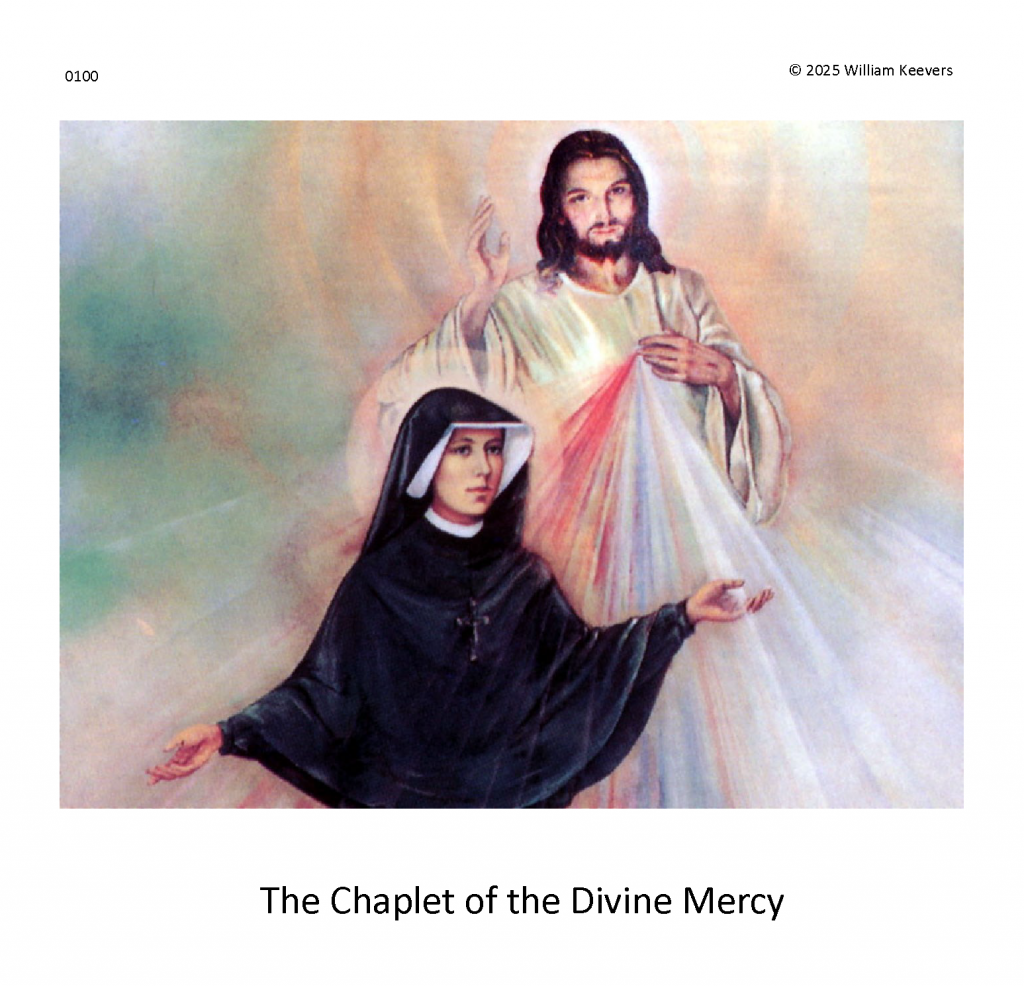
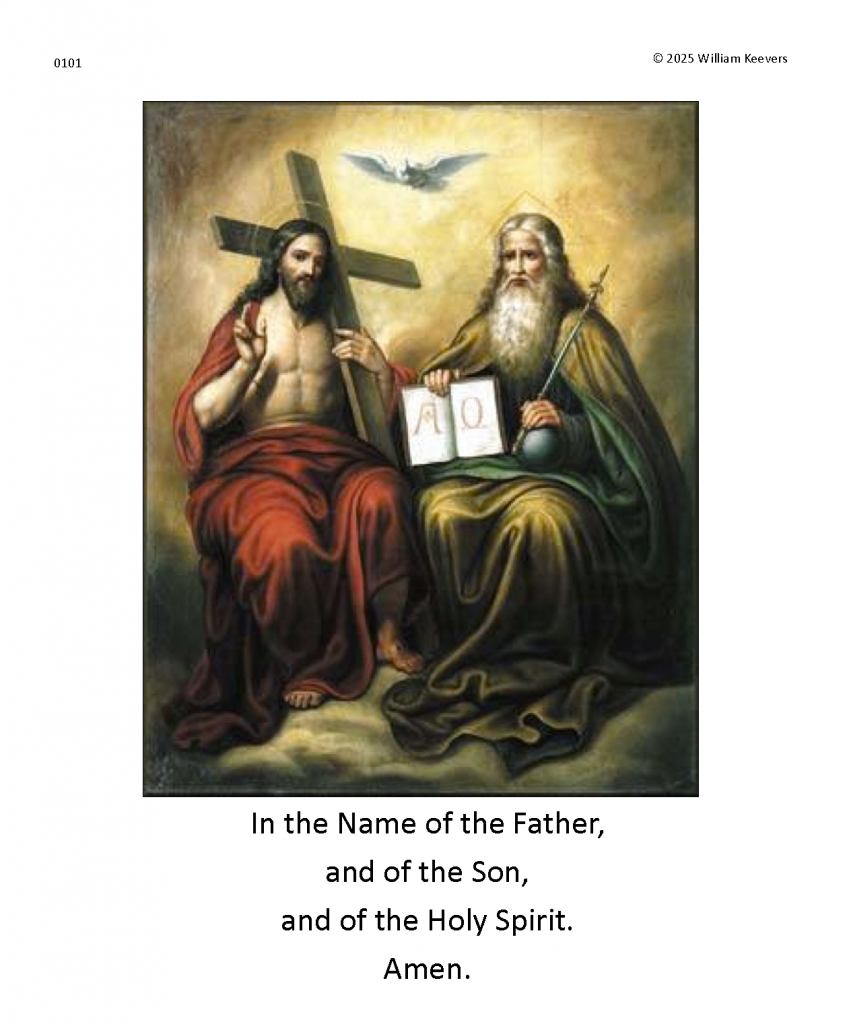
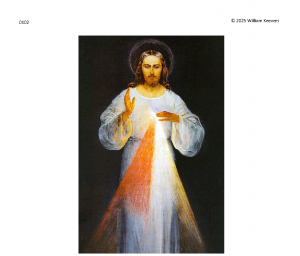
Thou didst expire, Jesus, but the source of life gushed forth for souls, and the ocean of mercy opened up for the whole world.

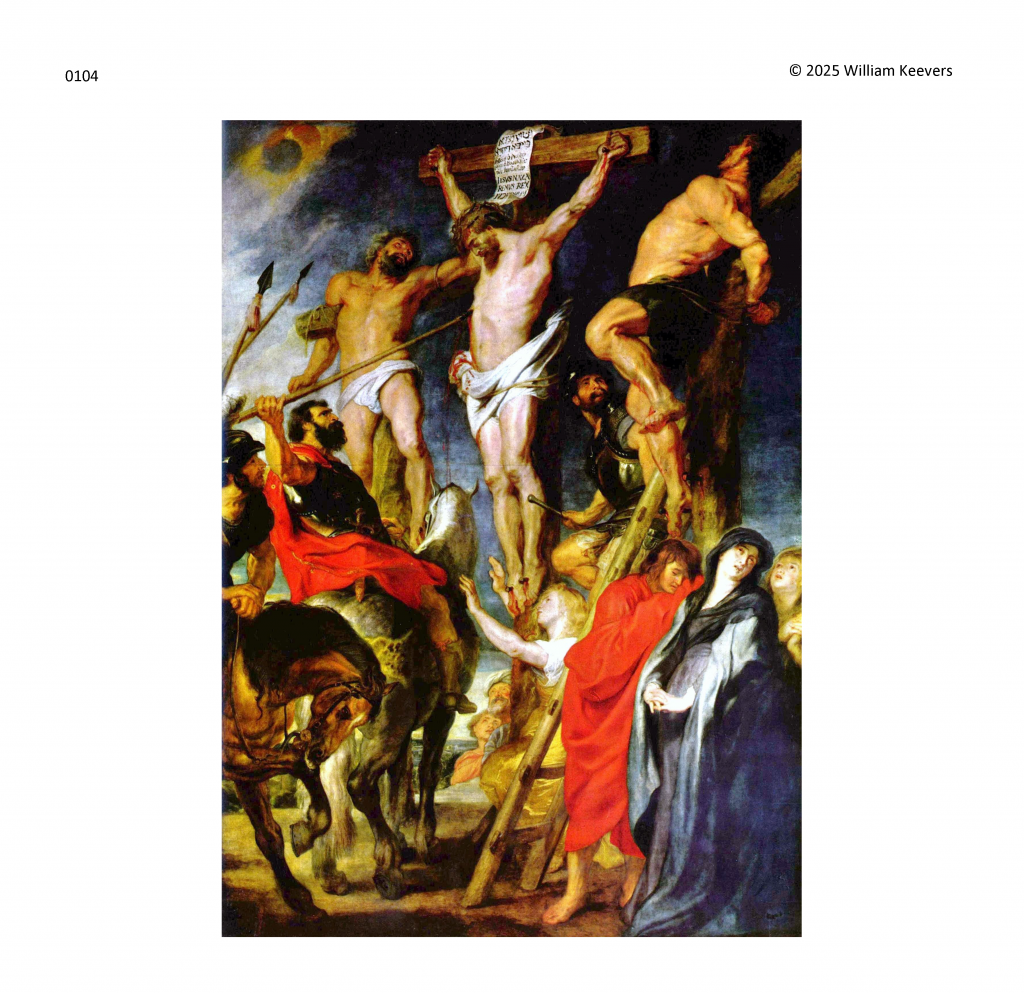
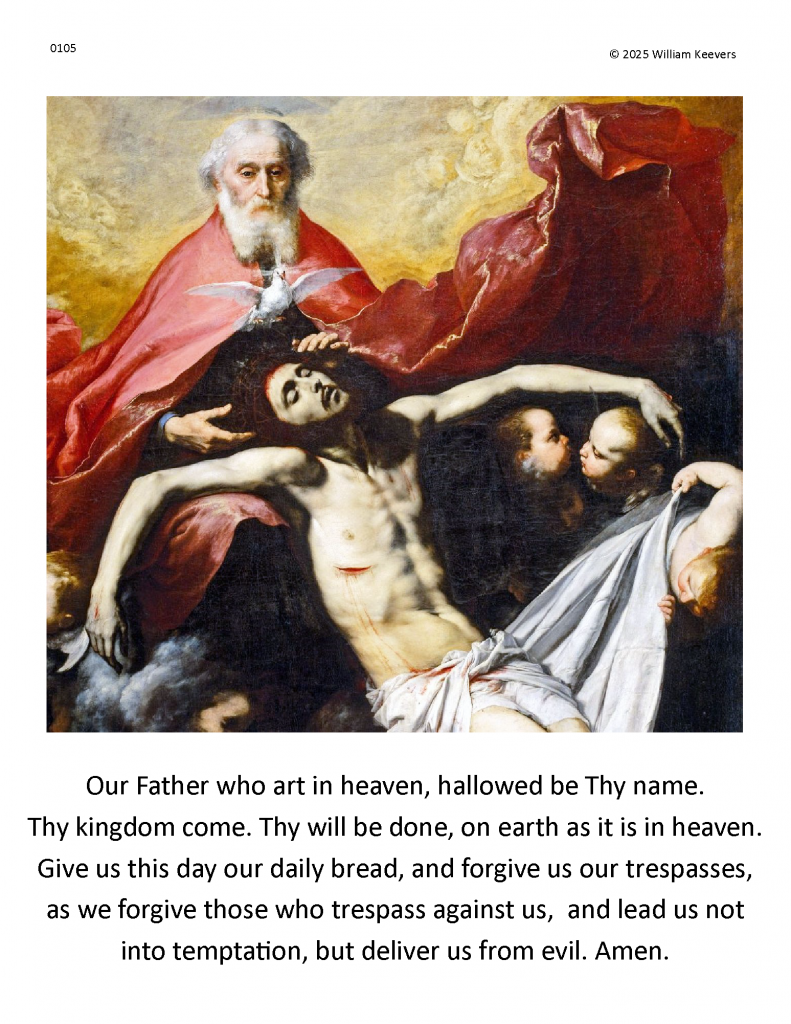
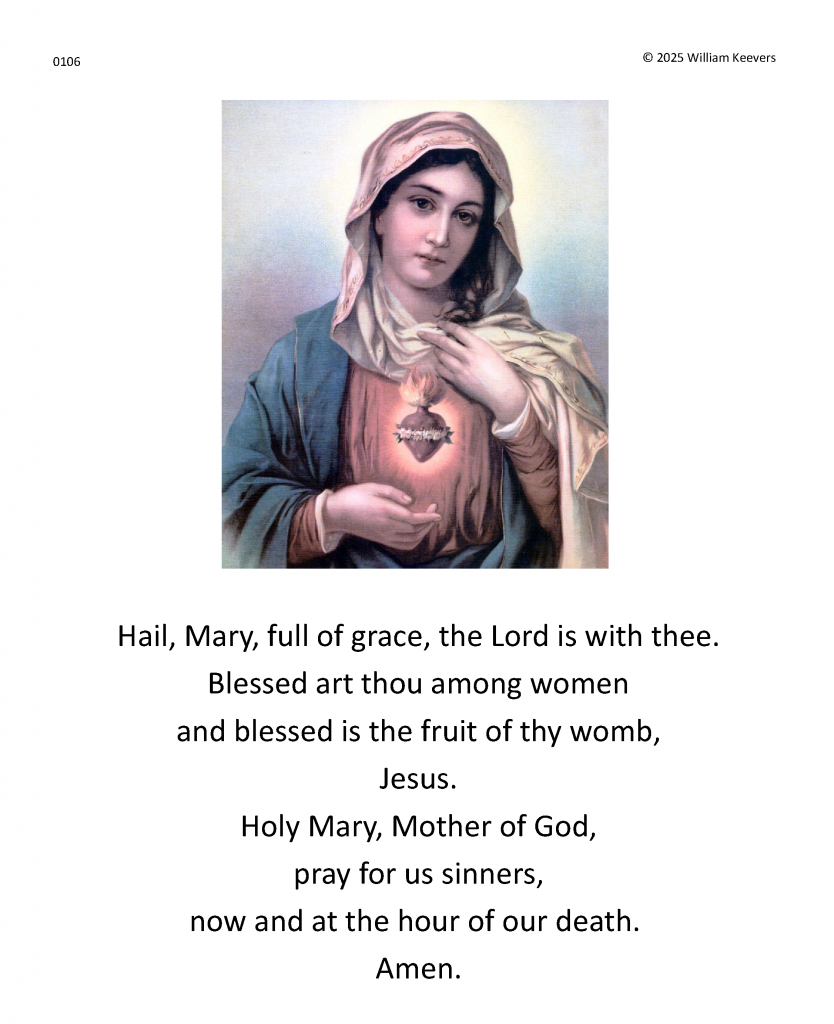
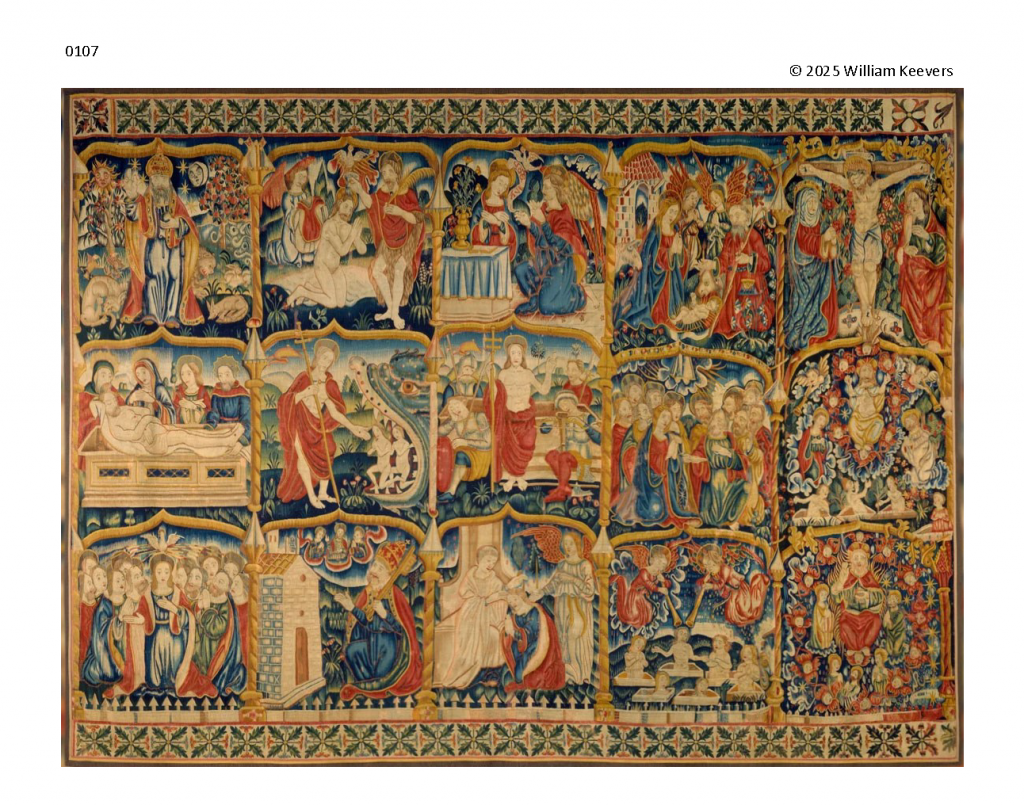
To audition background music for the First Decade of prayers of The Chaplet of the Divine Mercy, click the ▶ button to listen to an organ setting of the polyphonic acapella composition Ave Verum Corpus by the high Renaissance English composer William Byrd (1540-1623), or play the music in a New Window ⧉
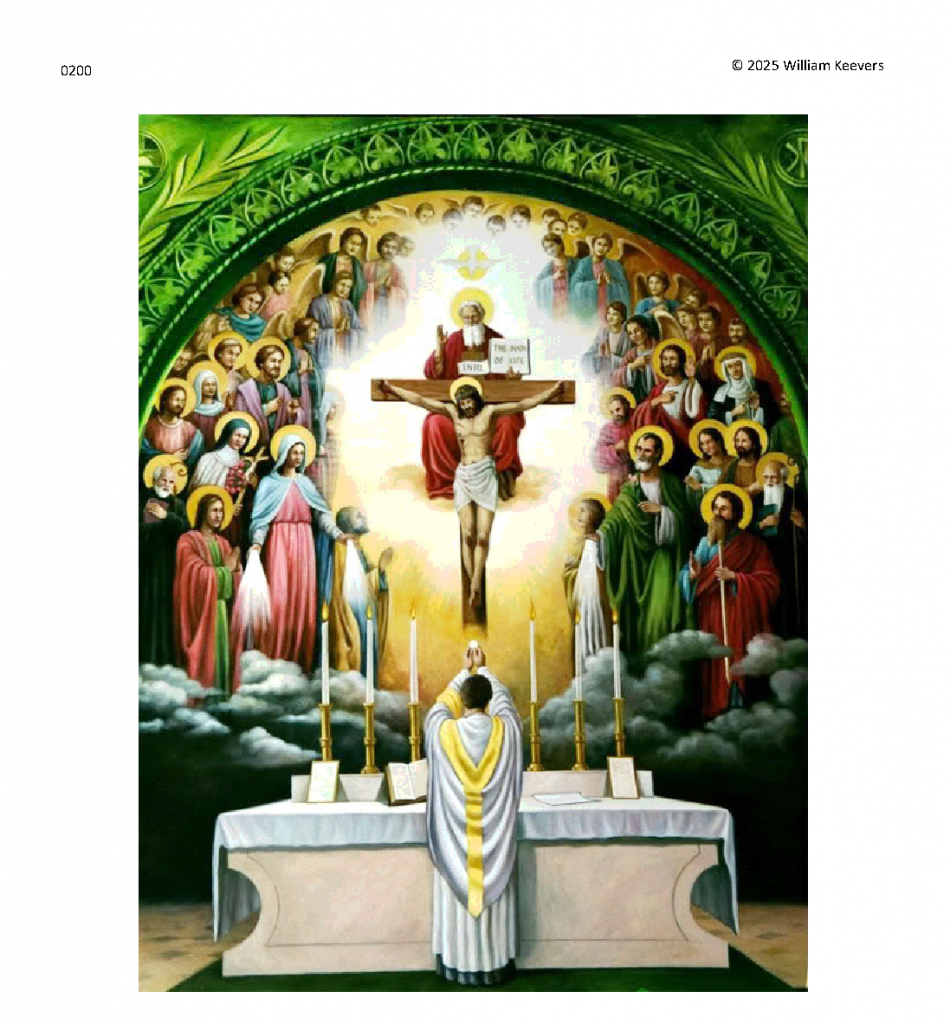

It was less the thought of His sufferings in His bitter Passion, than of the sins of men that afflicted Him, which caused Him this great dread of death.
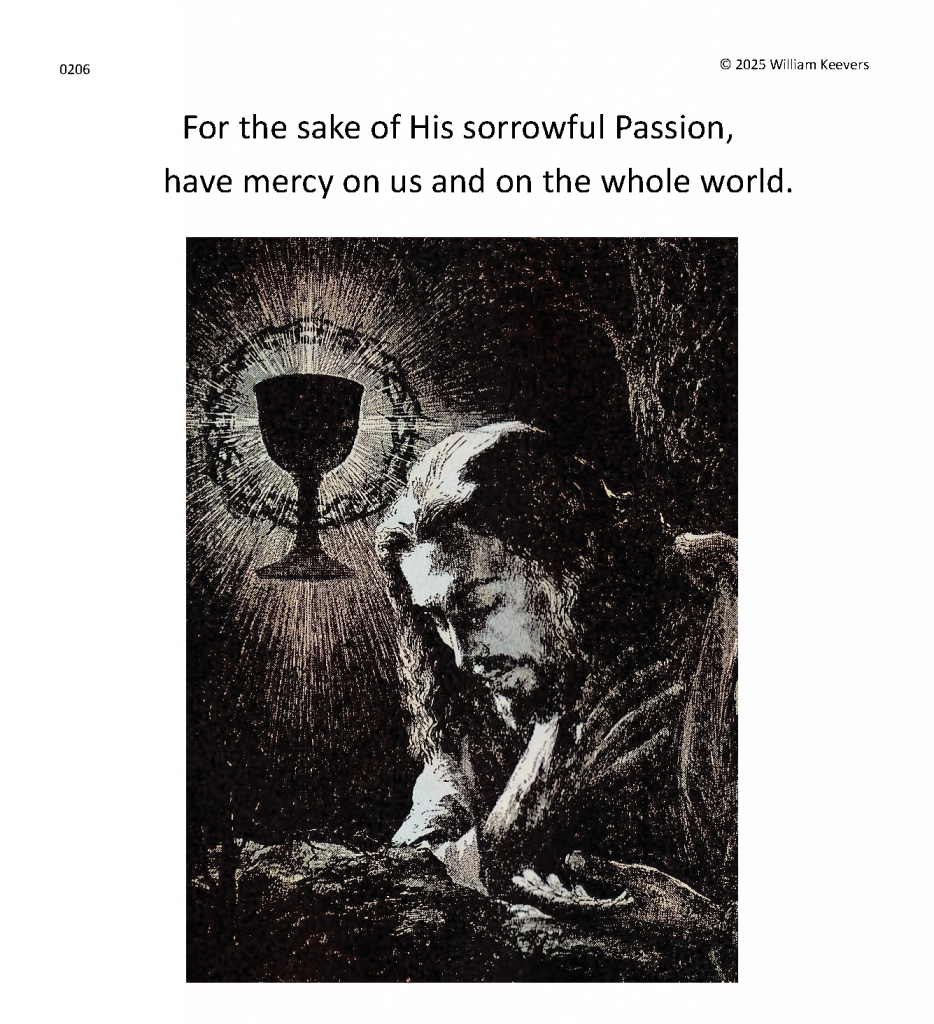
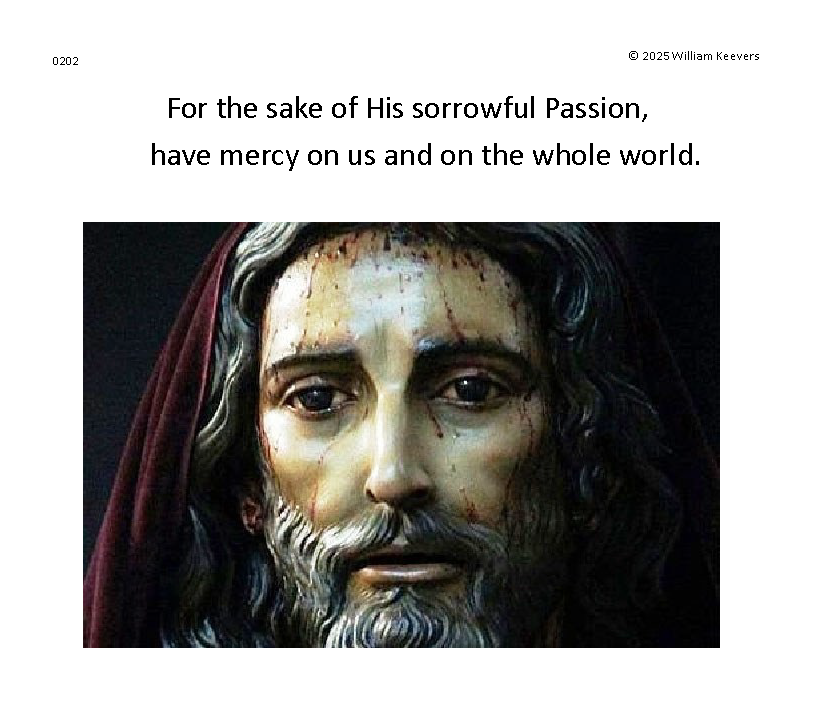
“God put Jesus forward as a propitiation for forgiveness of sins by His blood, by the sacrifice of Himself.” (Romans 3; Hebrews 9) Jesus was tormented in all the members and senses of His body, and was still more bitterly afflicted in all the powers of His soul; so that the internal pains which He endured infinitely surpassed His external sufferings.
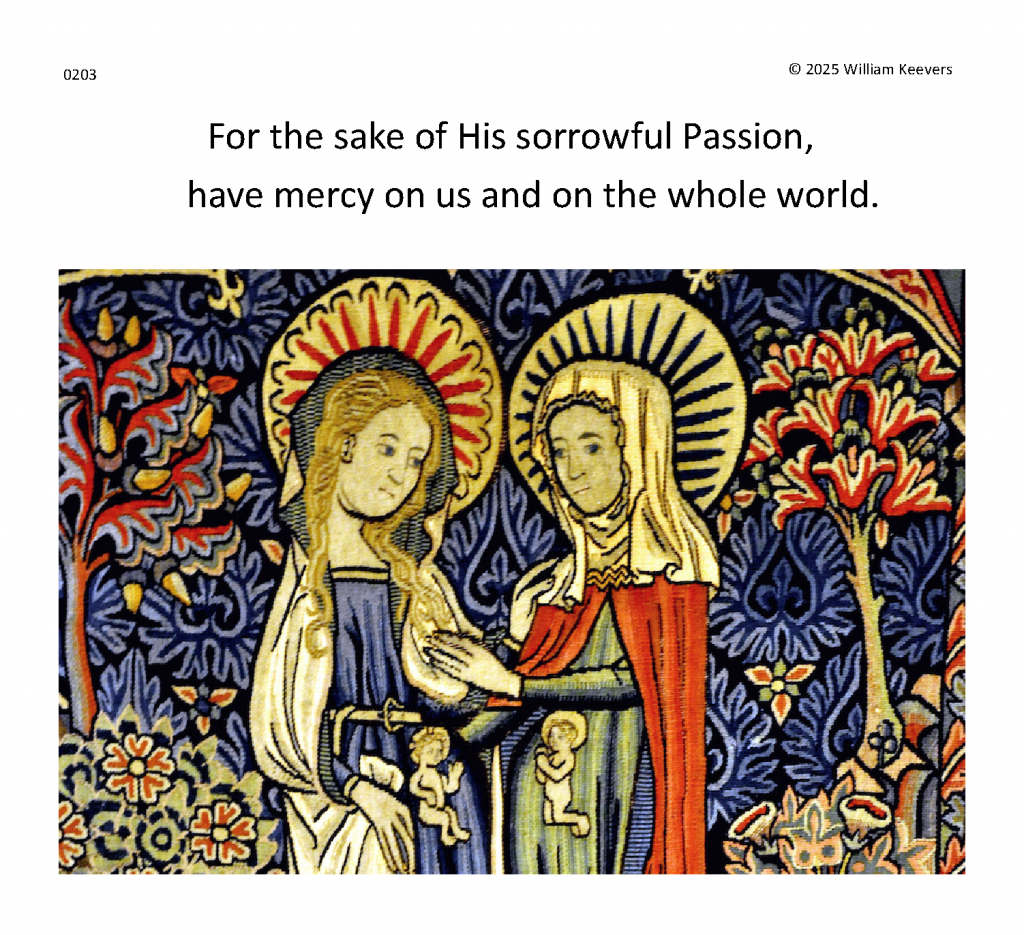
(In the Visitation, St. John the Baptist kneels within the womb of his mother, St. Elizabeth, adoring the Lord Jesus enthroned within the womb of His mother, the Blessed Virgin Mary.) Jesus even from the first instant of His life continually suffered all the torments of His Passion; He had before His eyes all the horrid scene of torments and insults which He was to receive from men, the scourges, the thorns, the cross, the outrages of His Passion, the desolate death that awaited Him. “My sorrow is continually before Me.” —Psalm 37:18
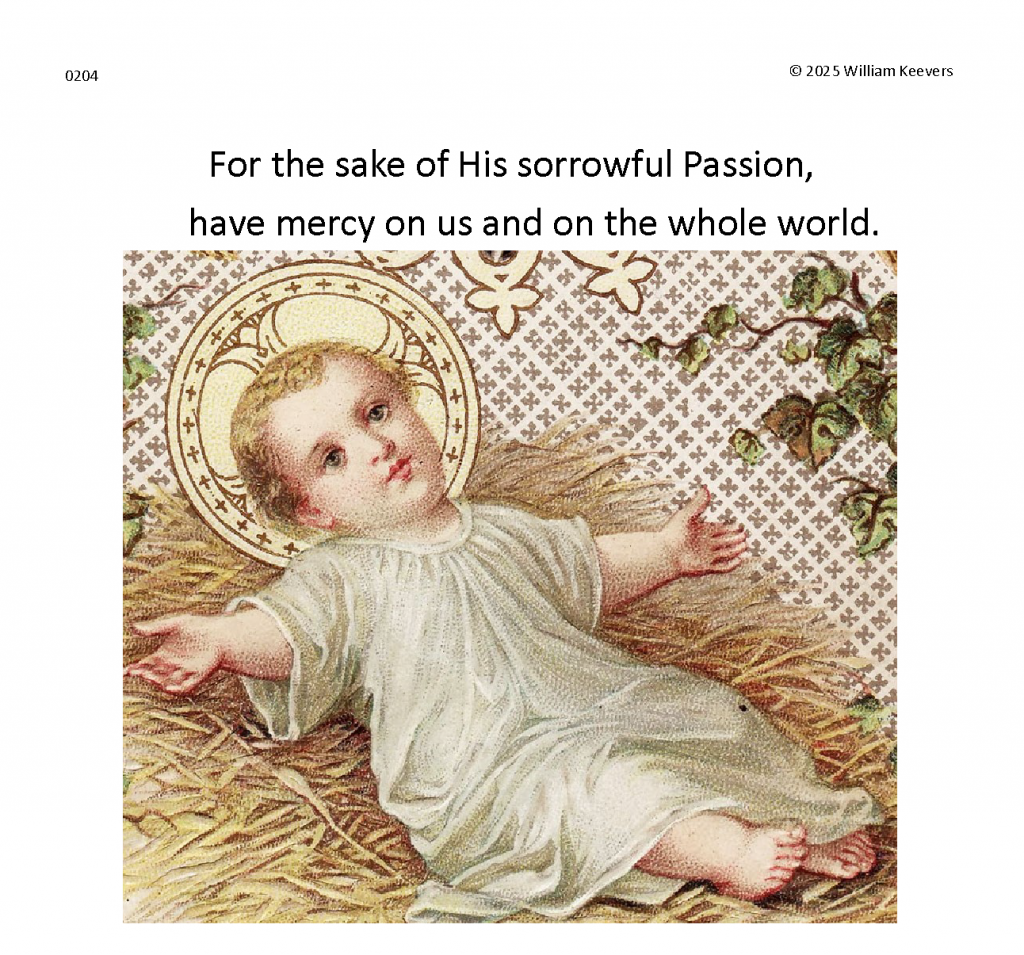
He came to die for love of us, that we might come to love Him. How is it possible for us to enter upon the meditation of the Passion of Jesus Christ without being wounded, as by so many darts of love, by those sufferings and agonies which so greatly afflicted the body and soul of our loving Lord, and without being sweetly constrained to love Him who loved us so much?
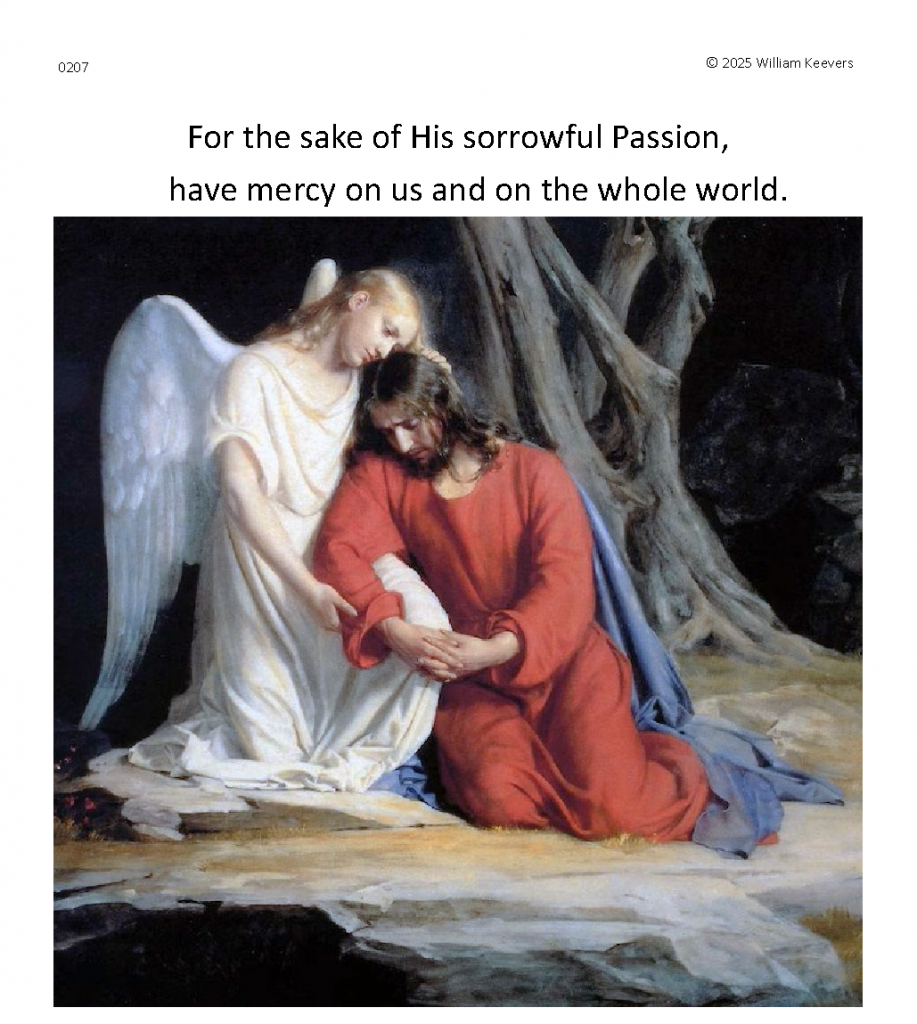
I die of love! … Come near and sustain Me in My mystic agony … Will you this evening be angels of consolation to me for one hour? – Fr. Mateo, January Holy Hour
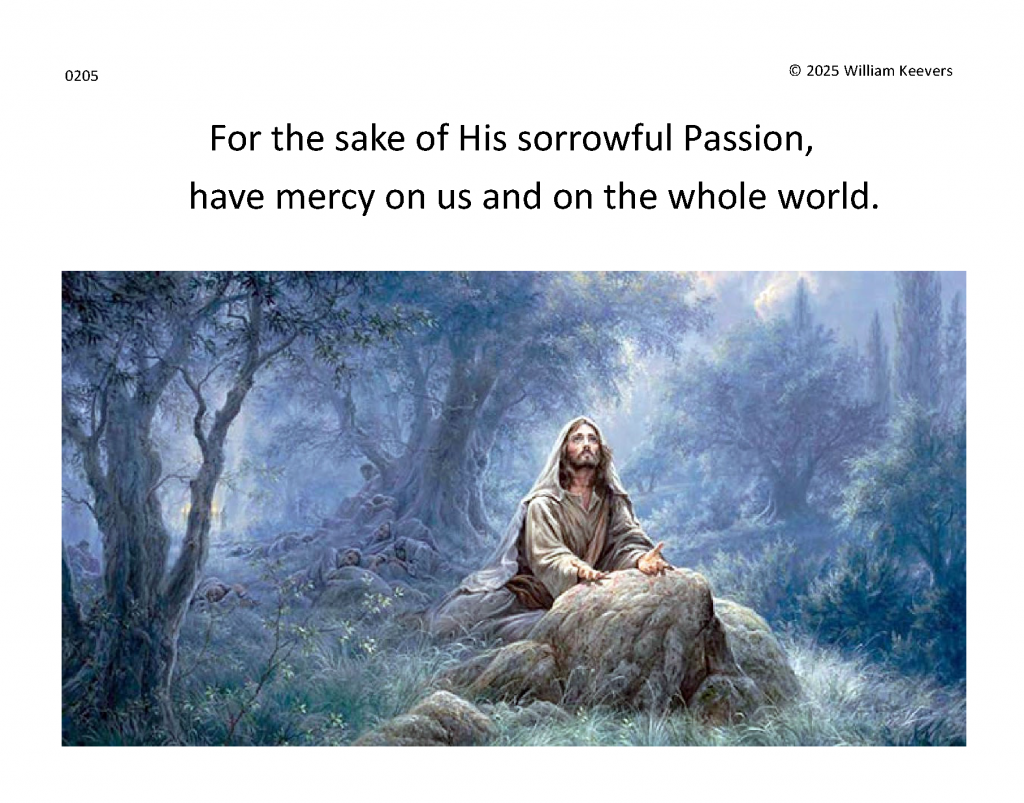
His greatest sorrow was that He saw how His Passion and death, offered with supreme love, would be of no avail to many souls. His infinitely meritorious Sacrifice, the power to save men from all their sins, would be received with indifference and ingratitude. “Souls do not want to accept My mercy.”
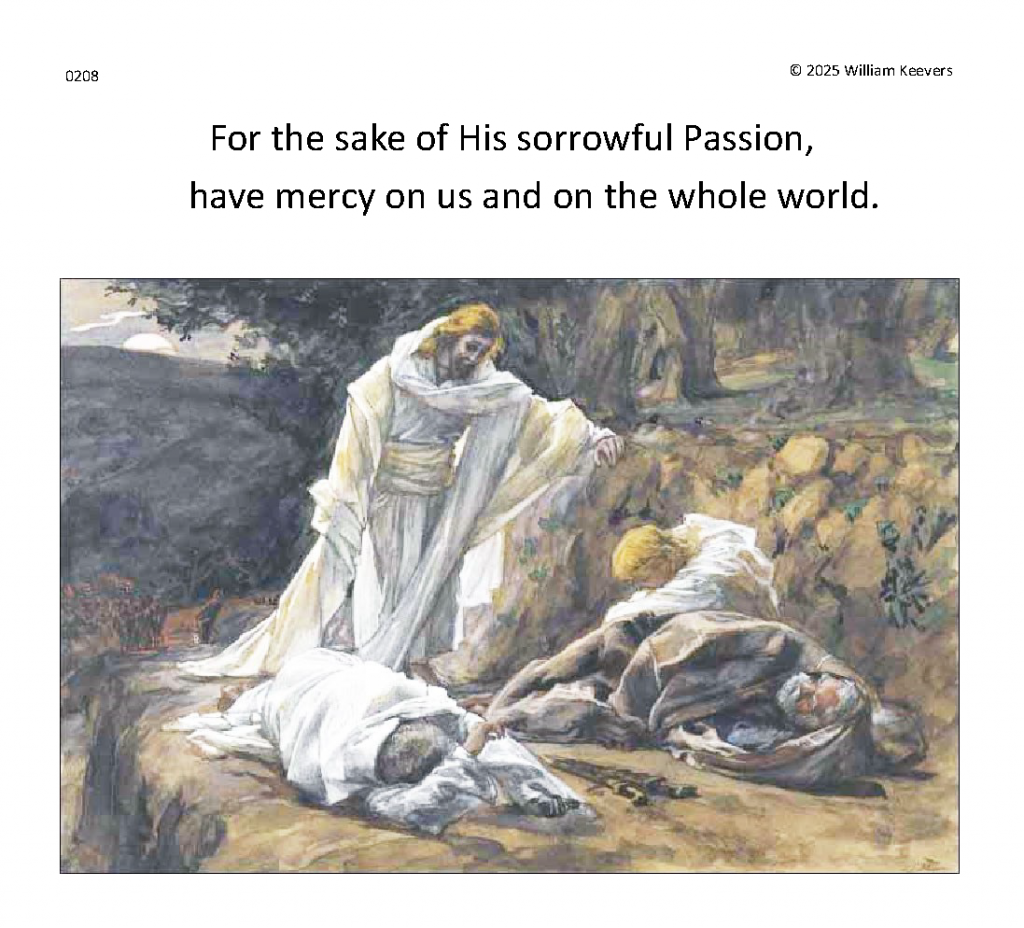
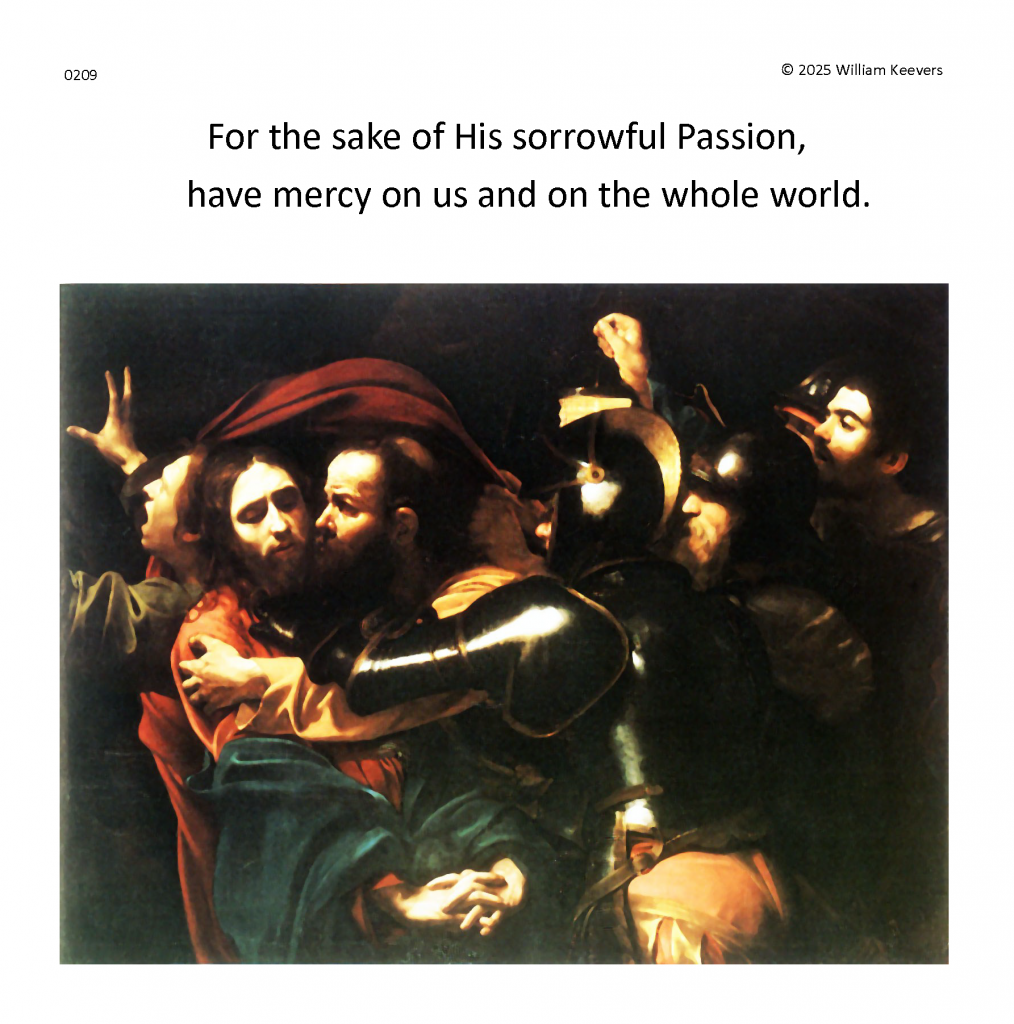
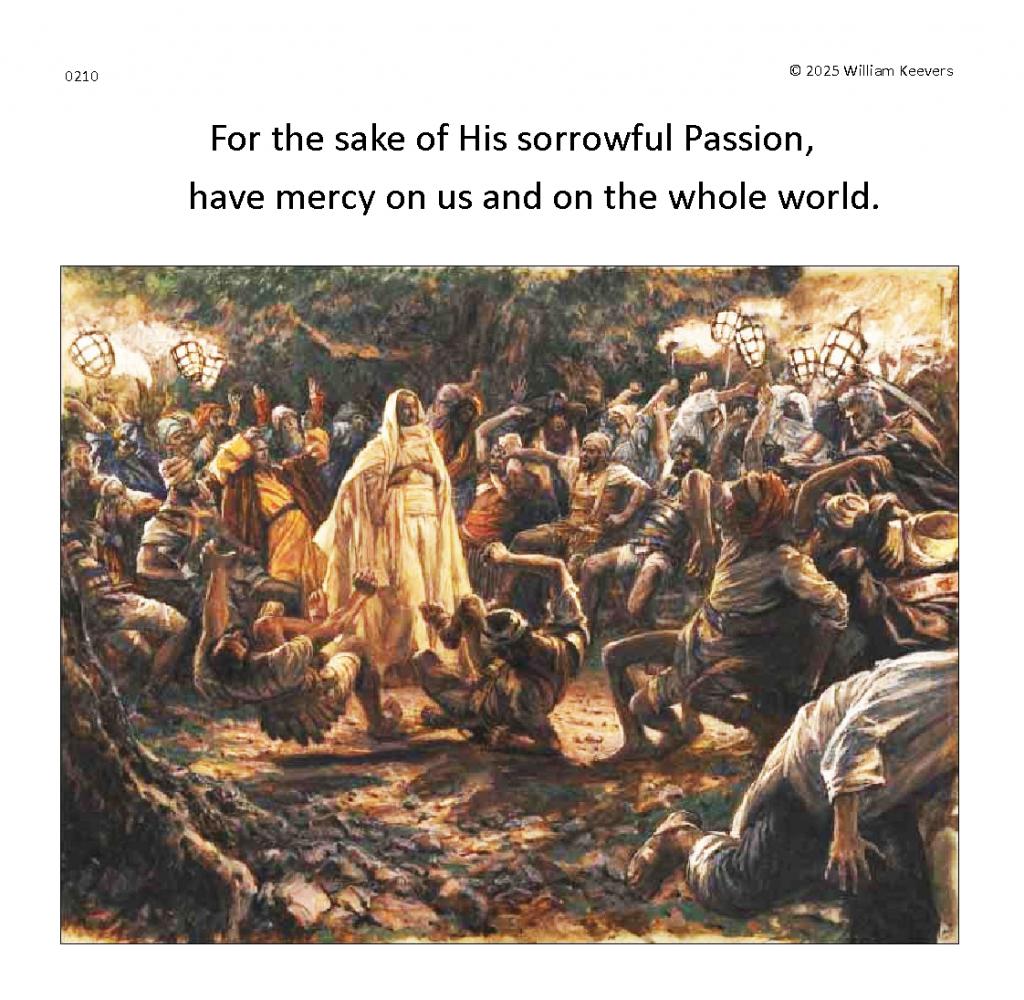
Moses said to God: Lo, I shall go to the children of Israel, and say to them: The God of your fathers hath sent me to you. If they should say to me: What is His name? what shall I say to them? God said to Moses: I AM WHO AM. (YHWH) He said: Thus shalt thou say to the children of Israel: HE WHO IS, hath sent me to you. And God said again to Moses: Thus shalt thou say to the children of Israel: The Lord God of your fathers, the God of Abraham, the God of Isaac, and the God of Jacob, hath sent me to you: This is My Name for ever, and this is My memorial unto all generations. – Exodus 3: 13-15
To audition background music for the Second Decade of prayers of The Chaplet of the Divine Mercy, click the ▶ button to listen to an organ setting of a composition of Ave Verum Corpus by the early French Baroque composer Marc-Antoine Charpentier (1643-1704), or play the music in a New Window ⧉

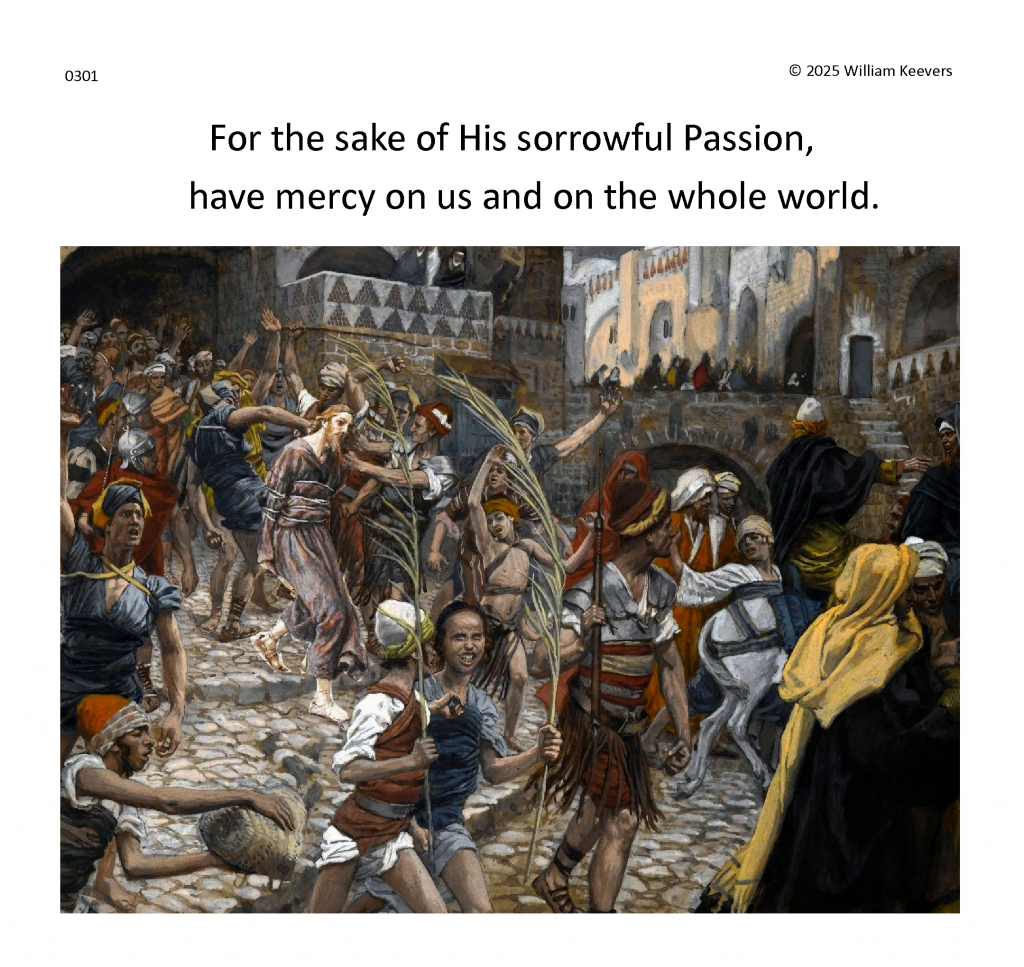
Greater love than this no man has, that He lay down His life for His friends. (John 15: 13) But He laid down His life for us, when we were not His friends, but enemies and rebels against Him.

Peter’s denial of Jesus, even swearing that he never knew Him, added to His sufferings. Jesus saith to Simon Peter: Simon son of John, lovest thou Me more than these? He saith to him: Yea, Lord, thou knowest that I love Thee. He saith to him: Feed My lambs. He saith to him again: Simon, son of John, lovest thou Me? He saith to Him: Yea, Lord, thou knowest that I love Thee. He saith to him: Feed My lambs. He said to him the third time: Simon, son of John, lovest thou Me? Peter was grieved, because He had said to him the third time: Lovest thou Me? And he said to Him: Lord, thou knowest all things: thou knowest that I love Thee. He said to him: Feed My sheep.
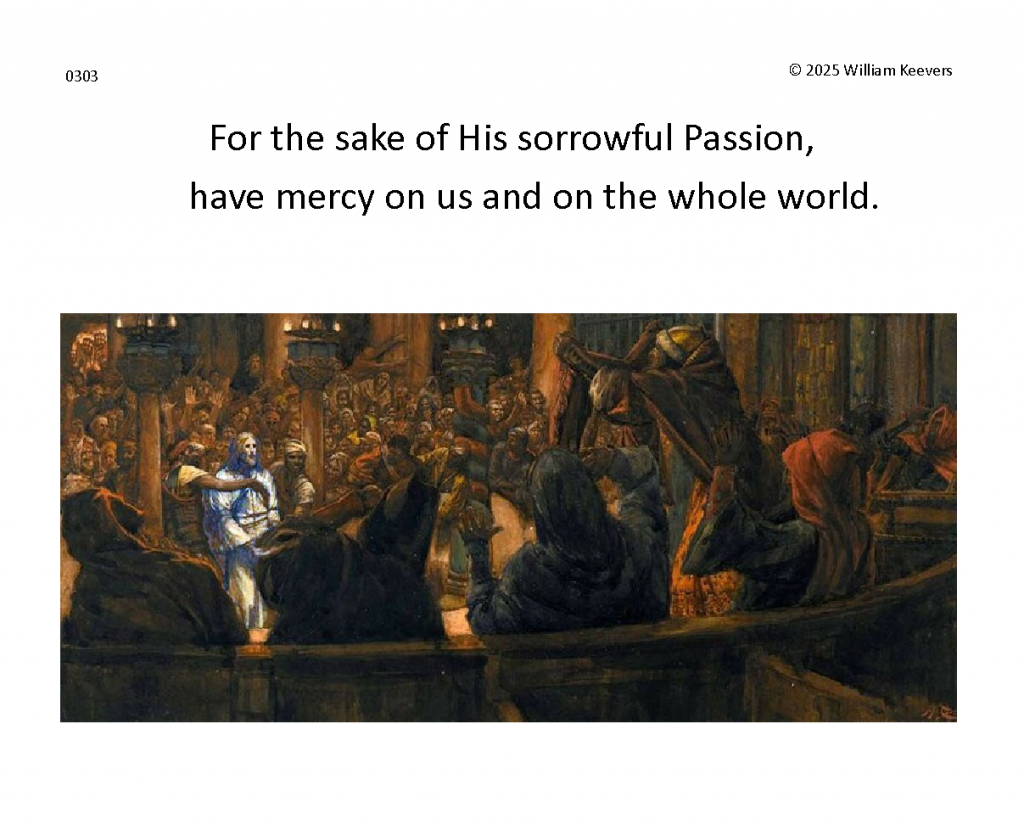
The ignominies and cruelties which our Lord suffered on that night were so manifold that they shall not all be known till the day of judgment.
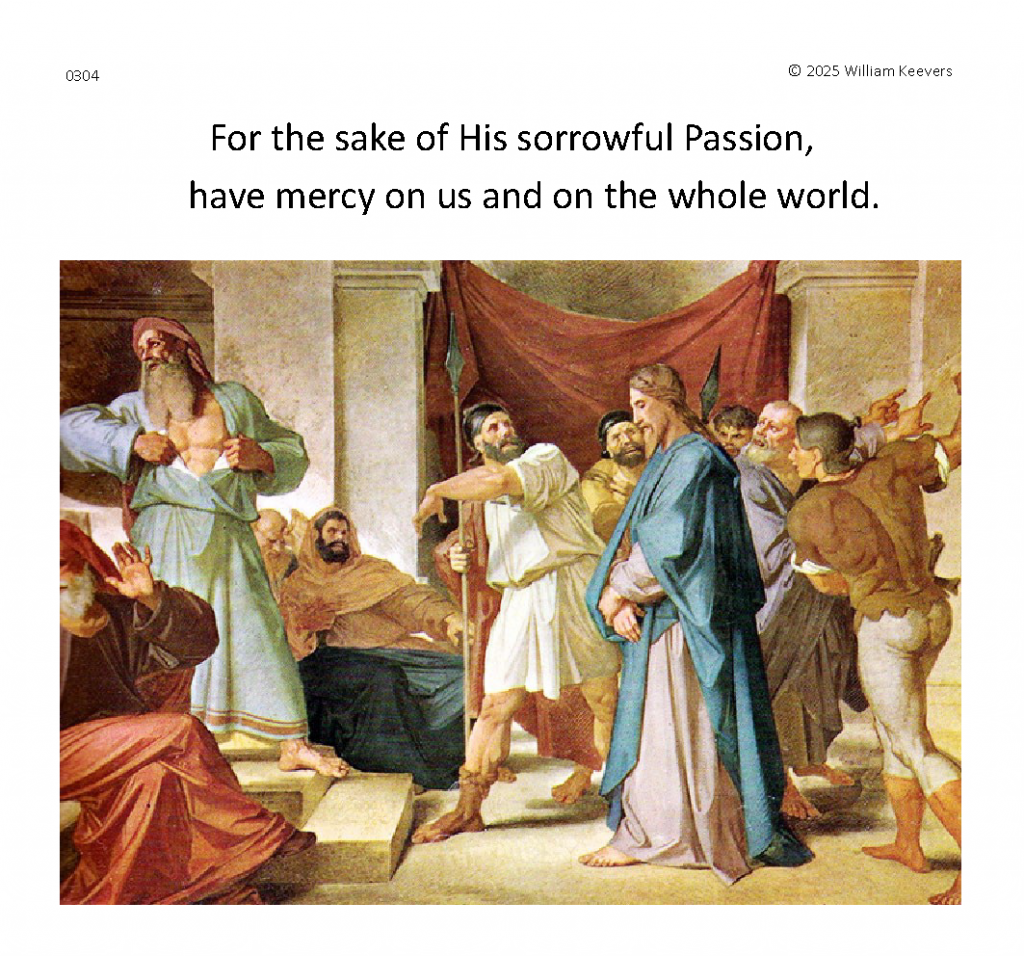
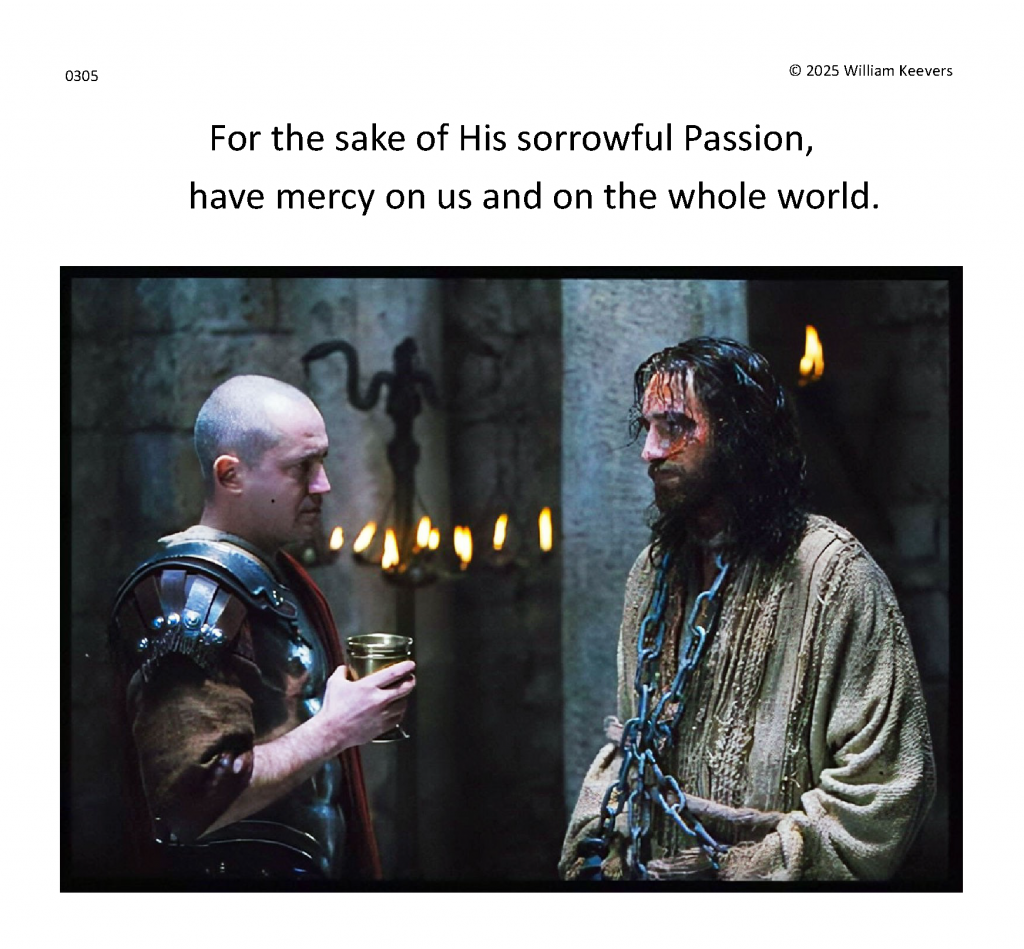

He was offered because it was His own will, and He opened not His mouth: He shall be led as a sheep to the slaughter, and shall be dumb as a lamb before His shearer, and He shall not open His mouth.
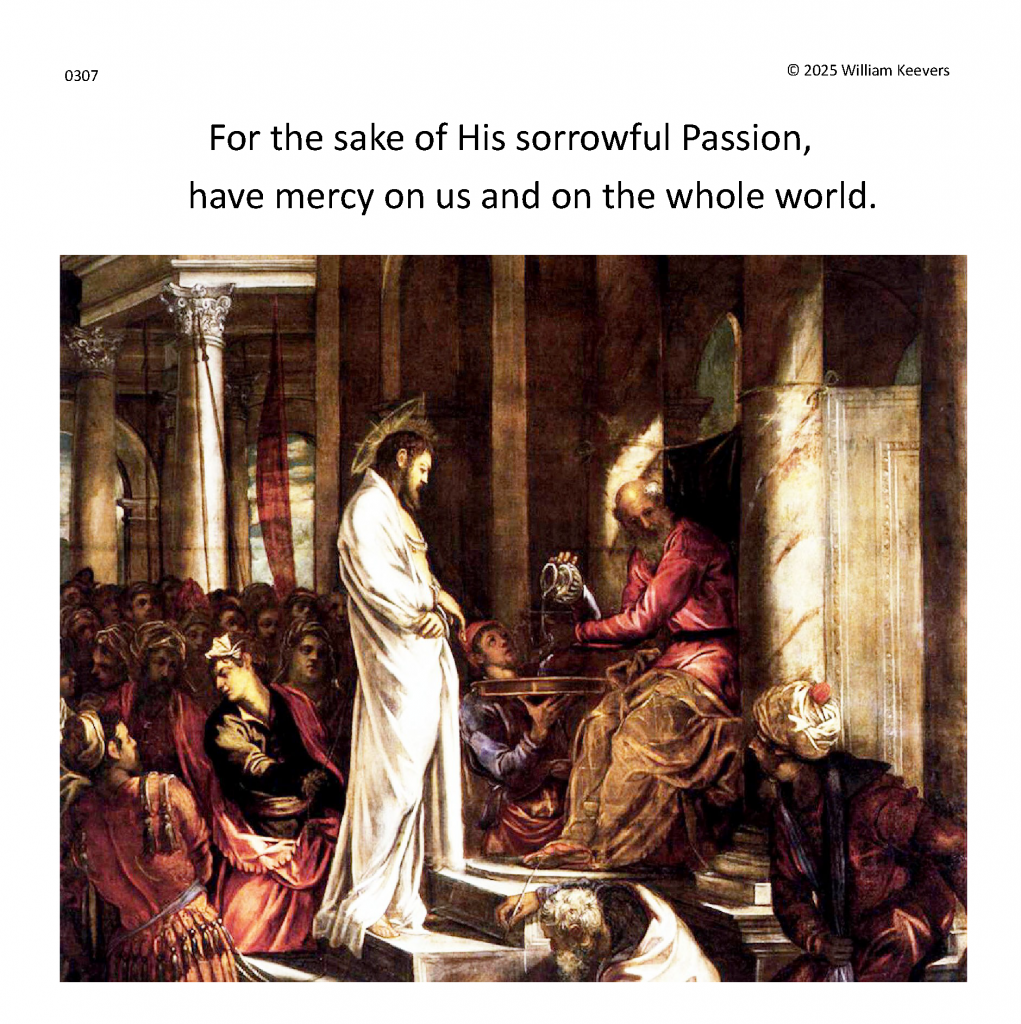
He was beaten, the chastisement inflicted on slaves only, to take on Himself the punishment due to us, of the slaves of sin.
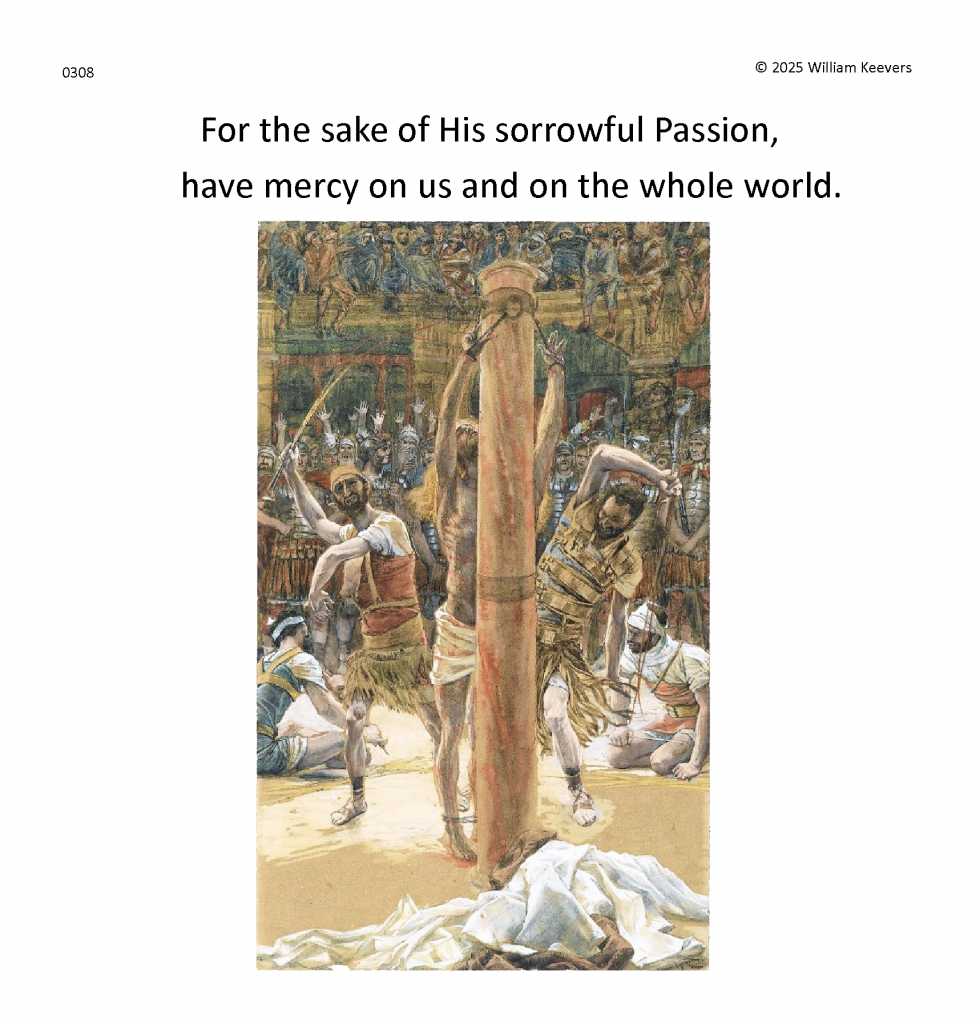

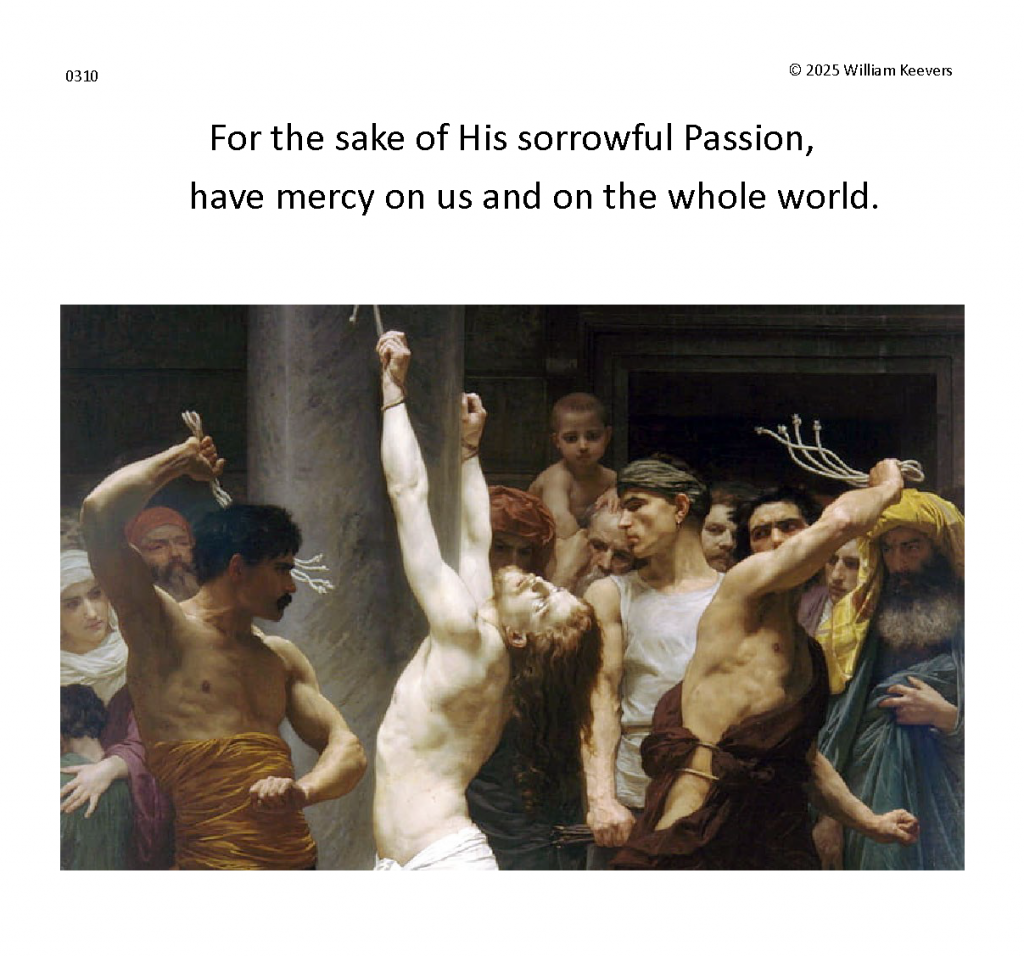
To audition background music for the Third Decade of prayers of The Chaplet of the Divine Mercy, click the ▶ button to listen to an organ setting of a composition of Ave Verum Corpus by the late Renaissance and early Baroque English composer Fr. Peter Philips (1560-1628), or play the music in a New Window ⧉
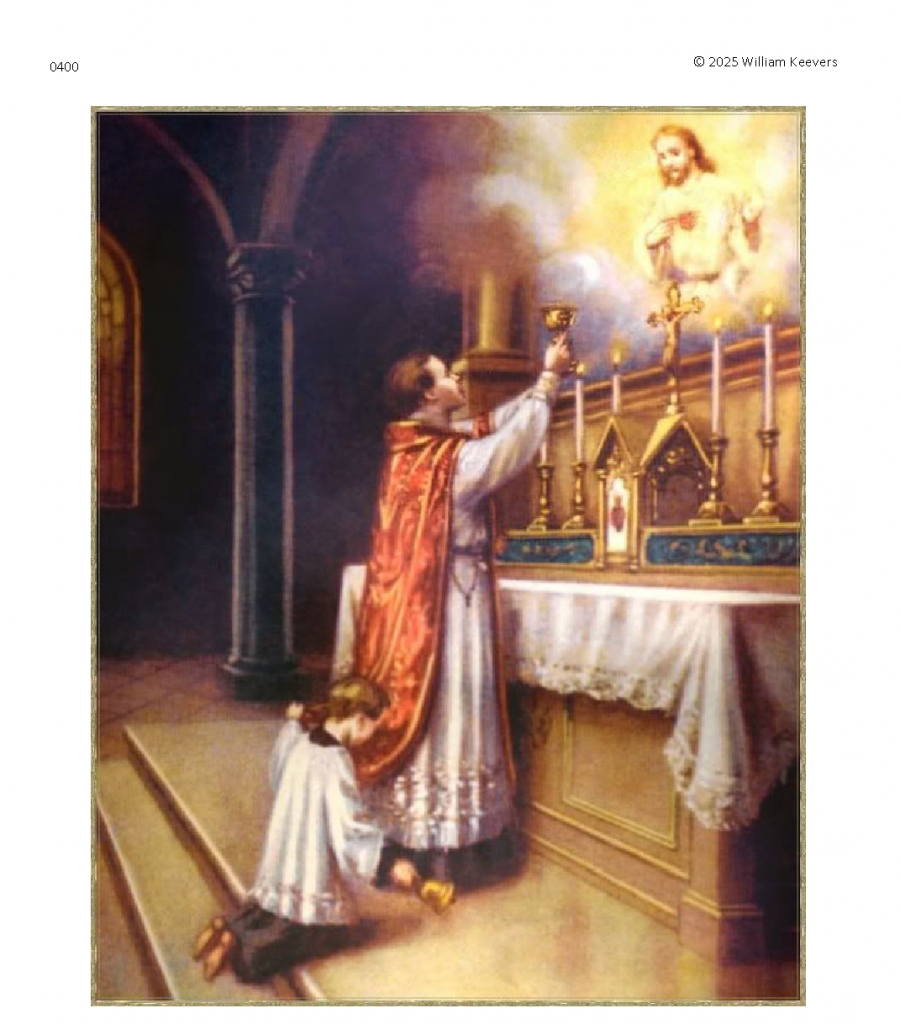




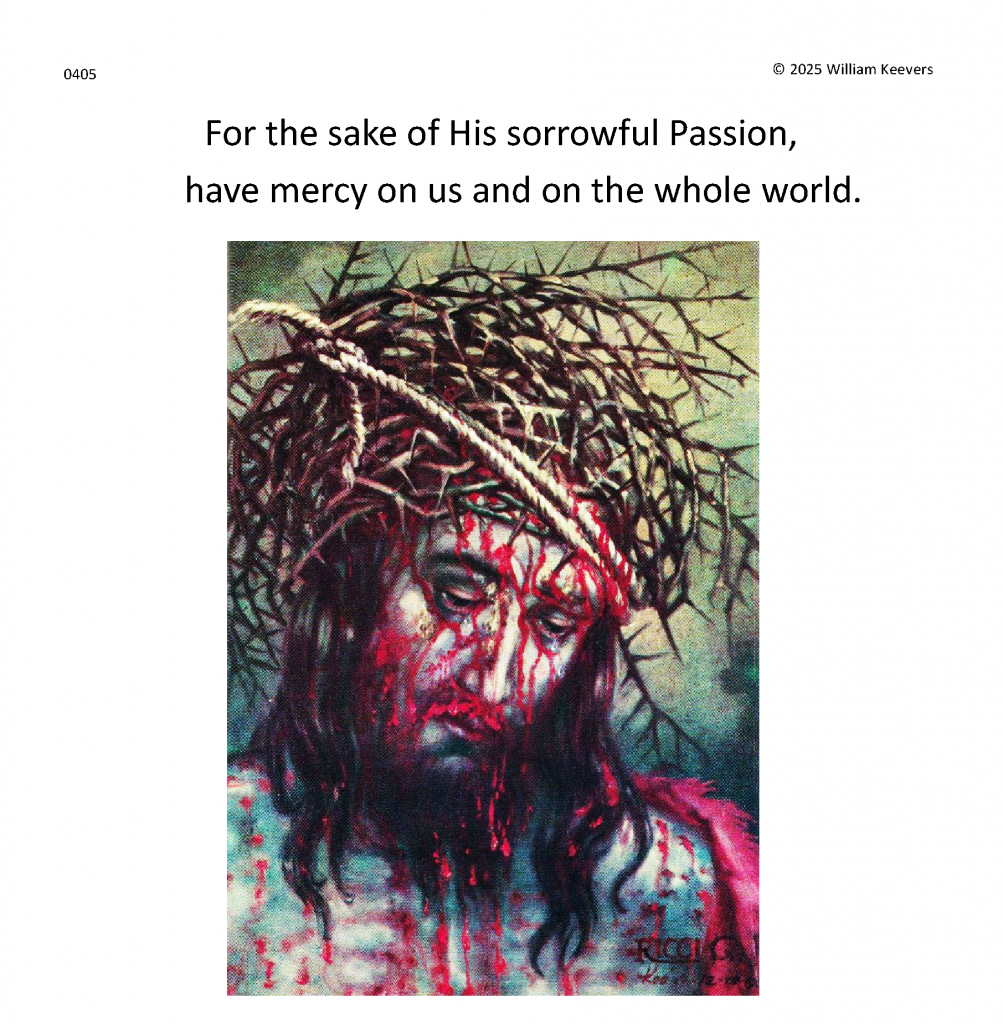
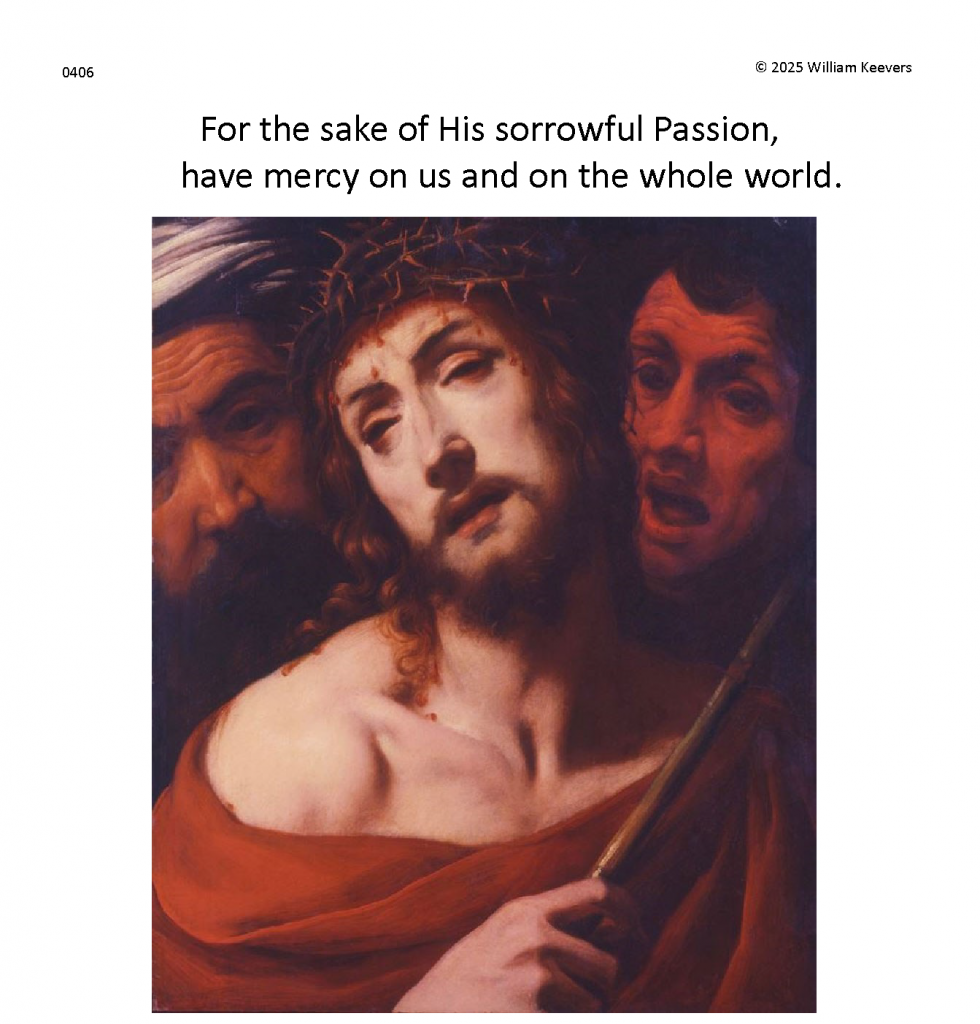
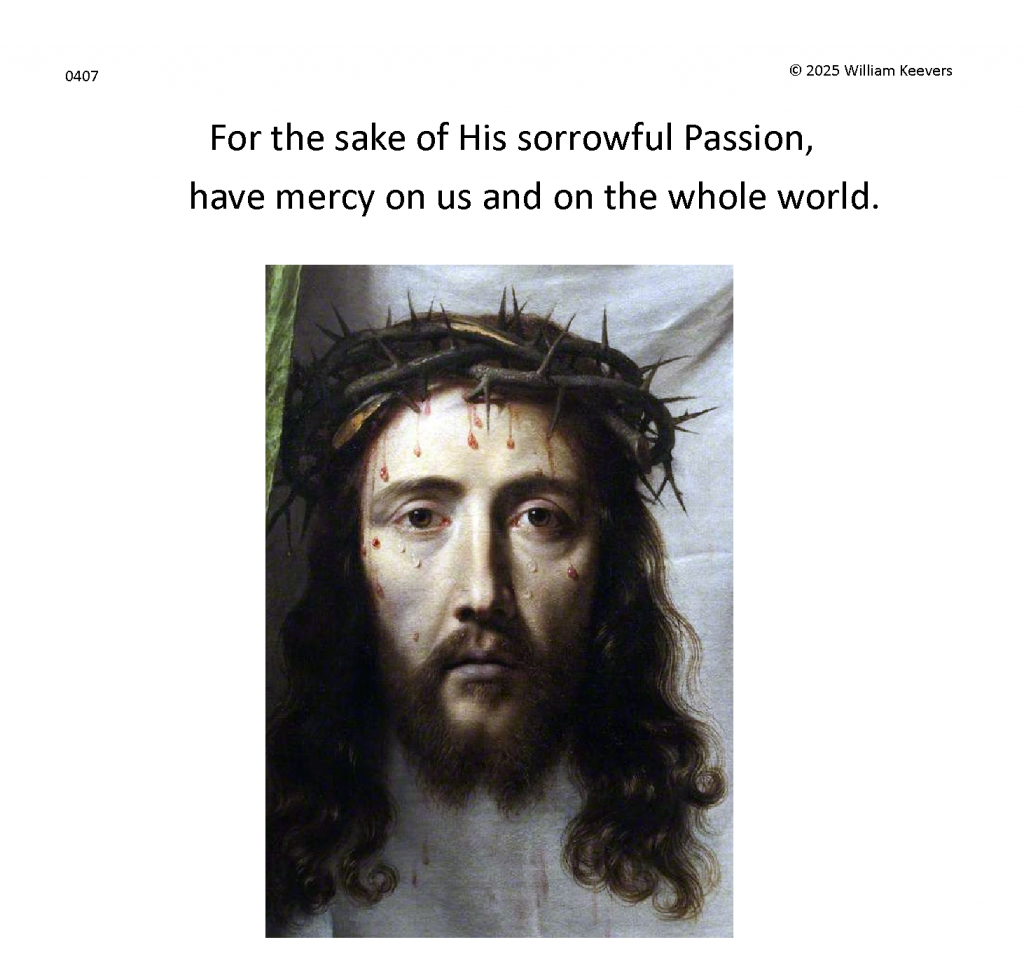
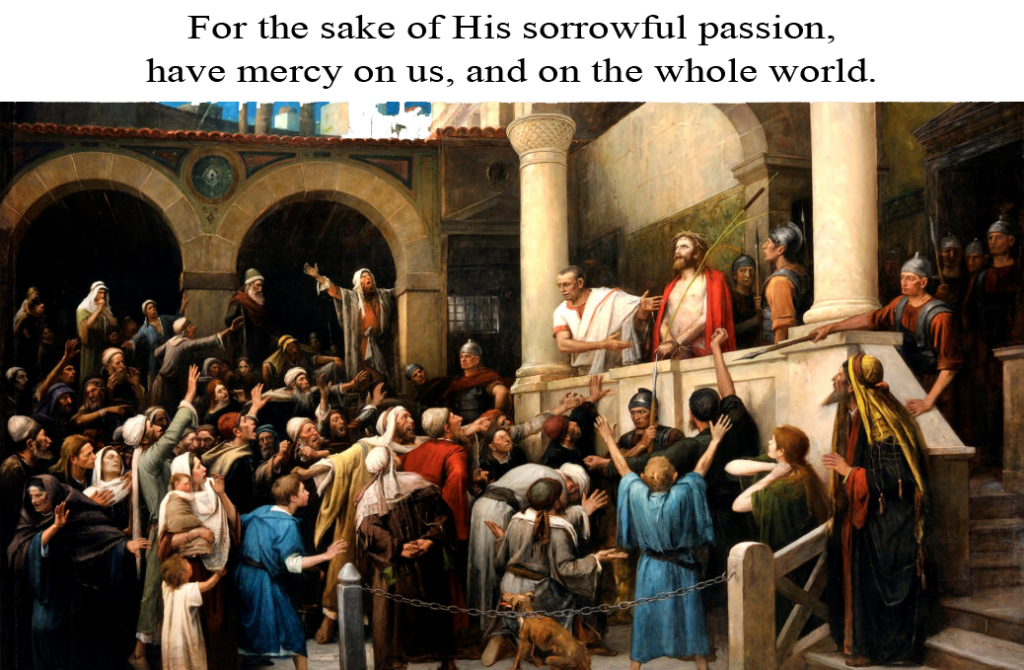

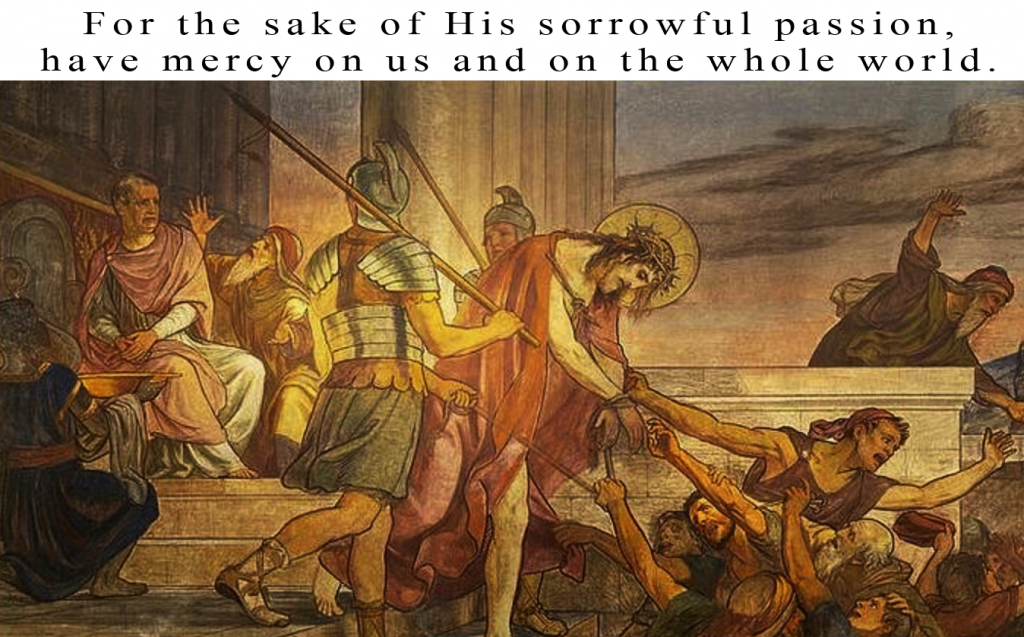
To audition background music for the Fourth Decade of prayers of The Chaplet of the Divine Mercy, click the ▶ button to listen to a setting of a composition of Ave Verum Corpus as adapted from a fragment of figured bass, traditionally called an Adagio, attributed to the 18th-century Venetian Baroque composer Tomaso Albinoni (1671-1751), by the twentieth century Italian musicologist and composer Remo Giazotto (1910-1998), or play the music in a New Window ⧉
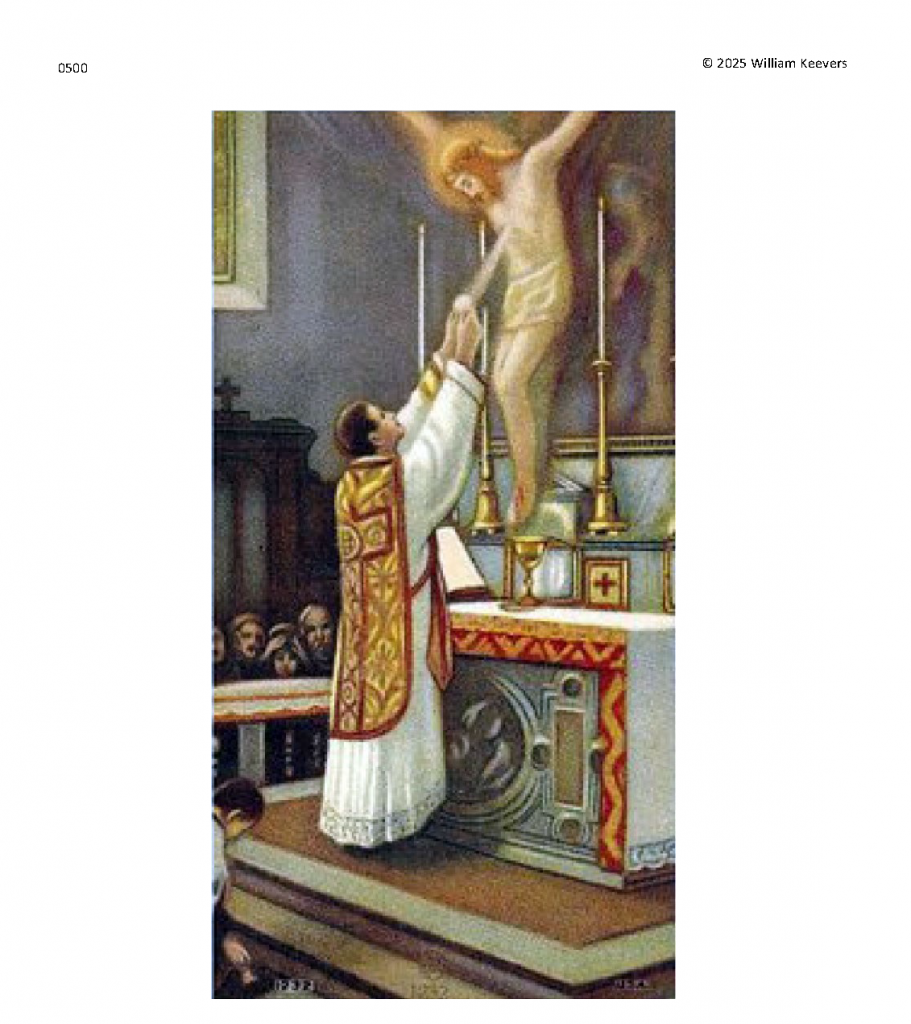


In the midst of condemned criminals there moves forward to death the King of heaven, the only-begotten Son of God, laden with His cross, to be executed, together with the malefactors, upon a gibbet of infamy.
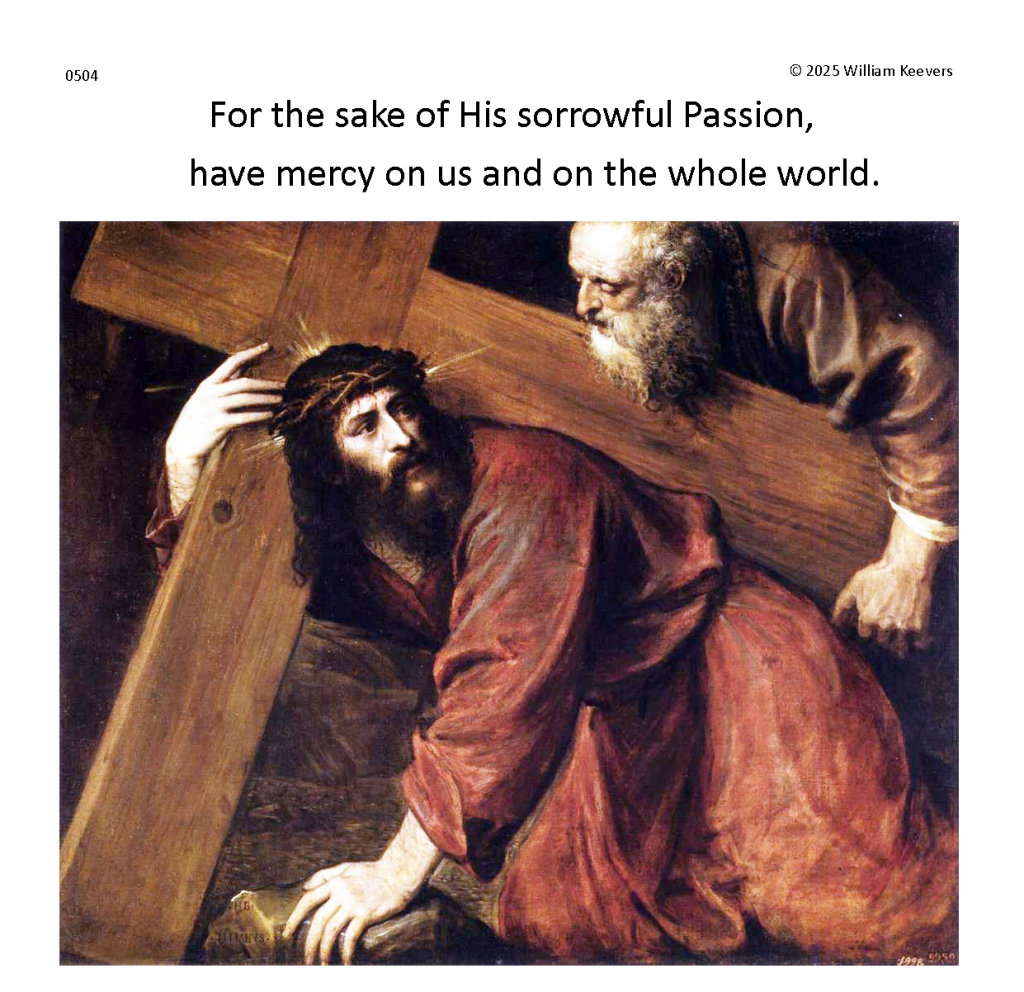
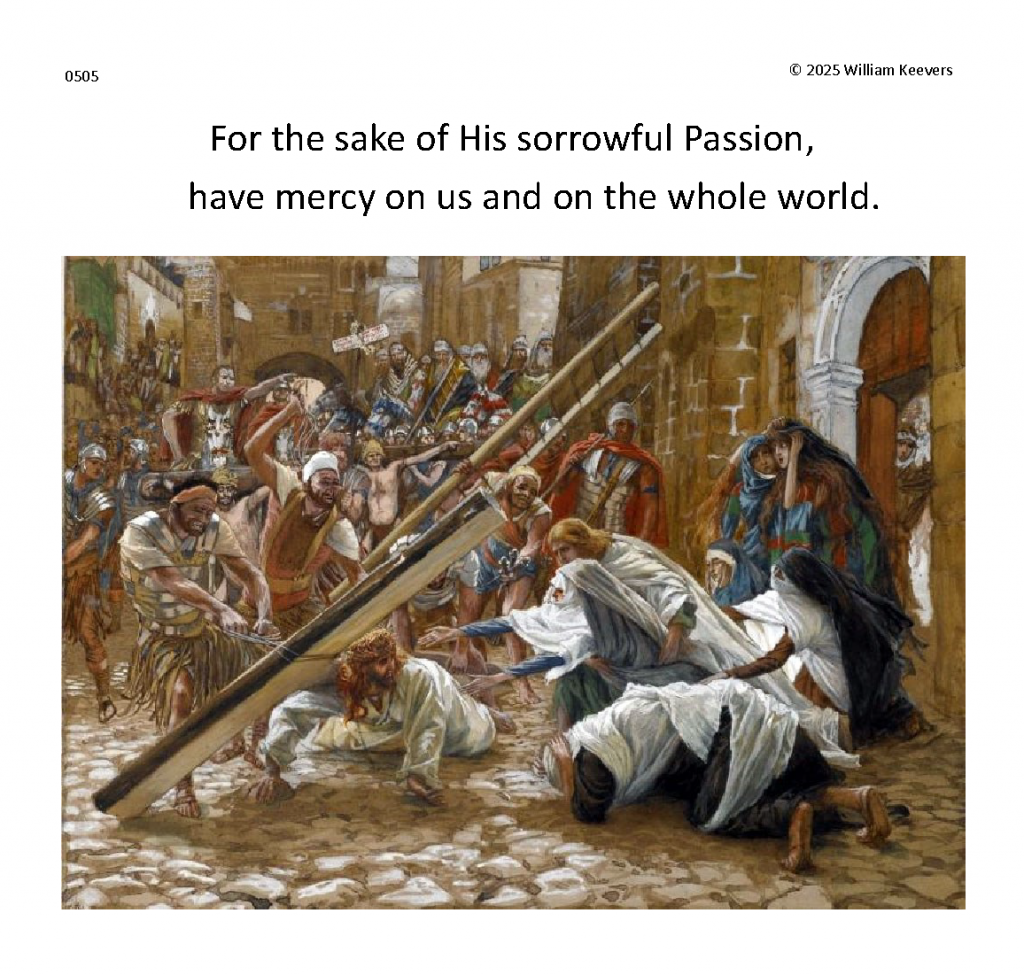

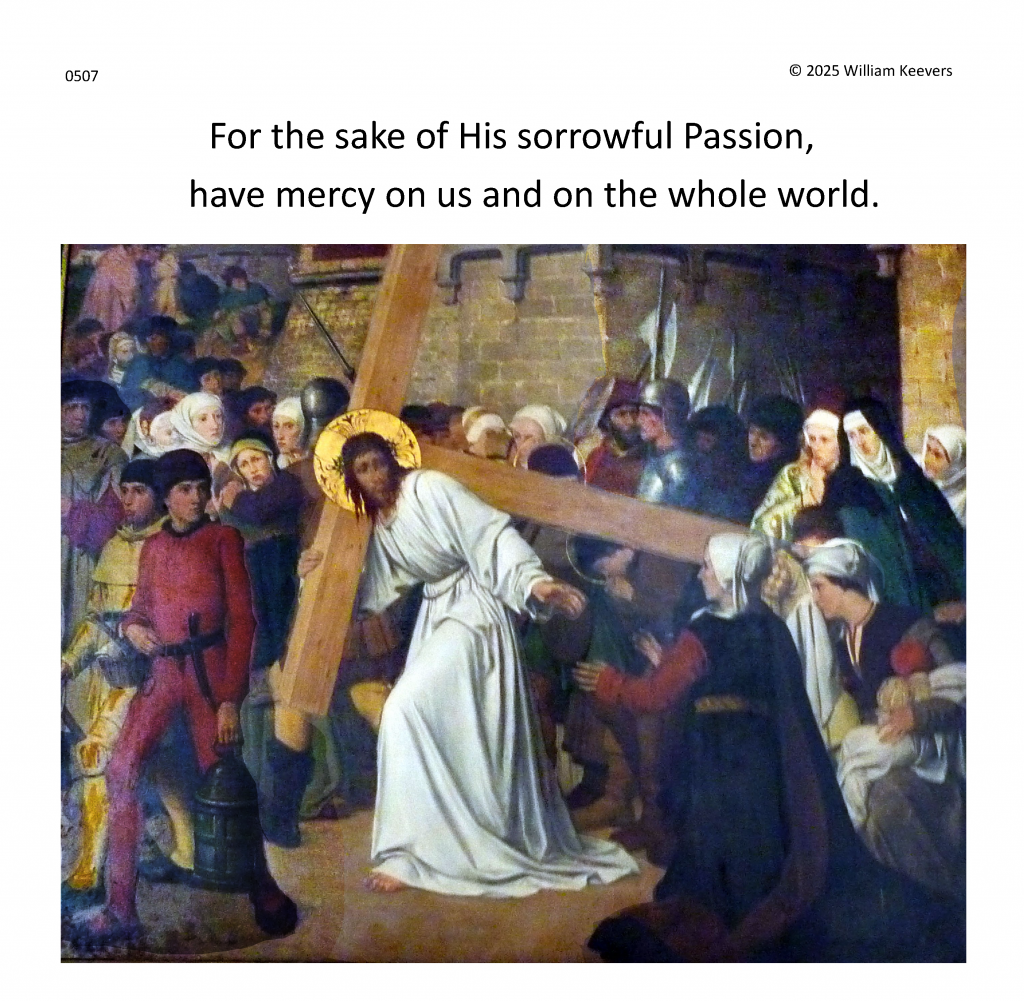


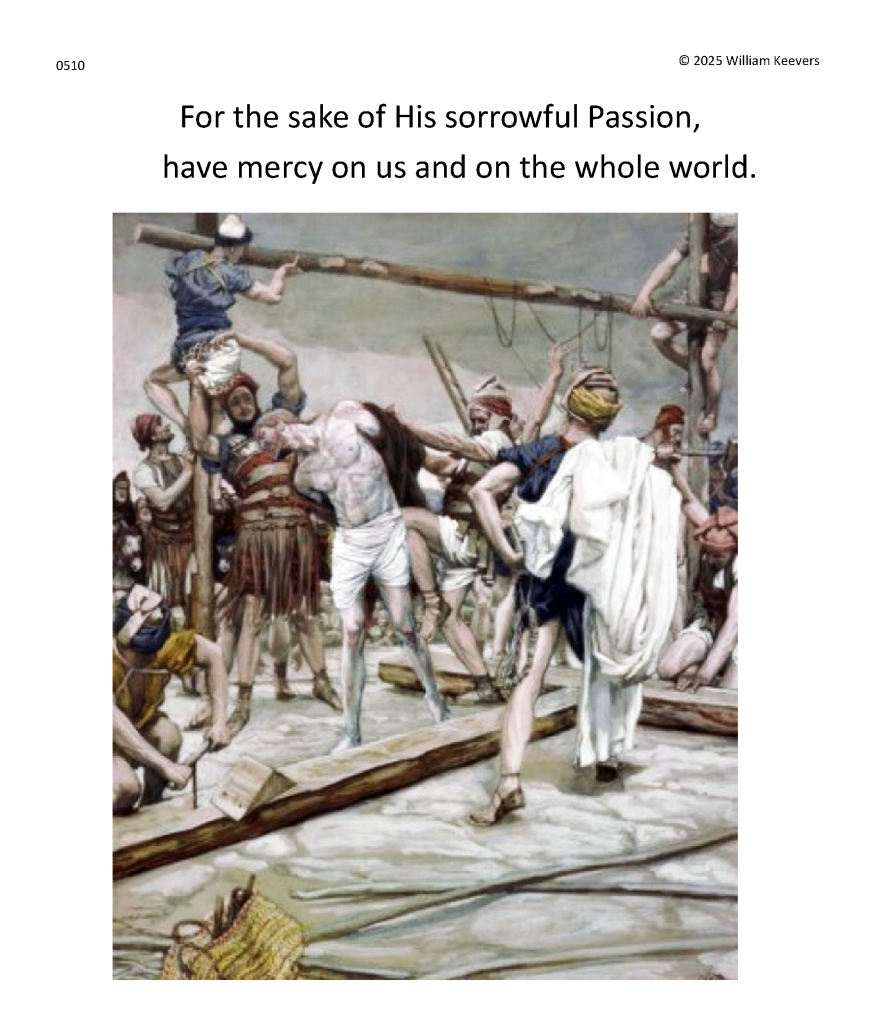

I lay down My life; no one taketh it away from Me, but I lay it down of Myself.
To audition background music for the Fifth Decade of prayers of The Chaplet of the Divine Mercy, click the ▶ button to listen to a polyphonic organ setting, implicitly in a minor mode, of the Gregorian Plainchant Ave Verum Corpus, the original attributed to Pope Innocent VI (1282-1362), or play the music in a New Window ⧉

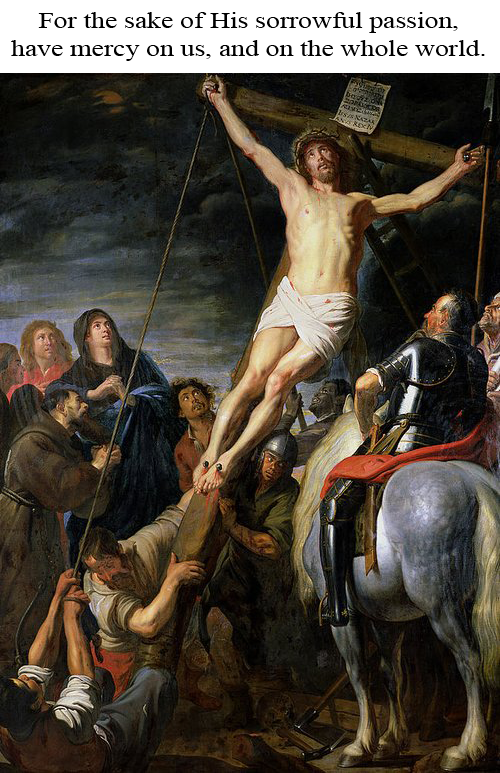
O Son, Divine Lord, made man, draw me entirely to Thyself, detach me from earth, crucify me with Thyself that I may become, in union with Thee, a sacrifice of praise for the glory of Thy Father.
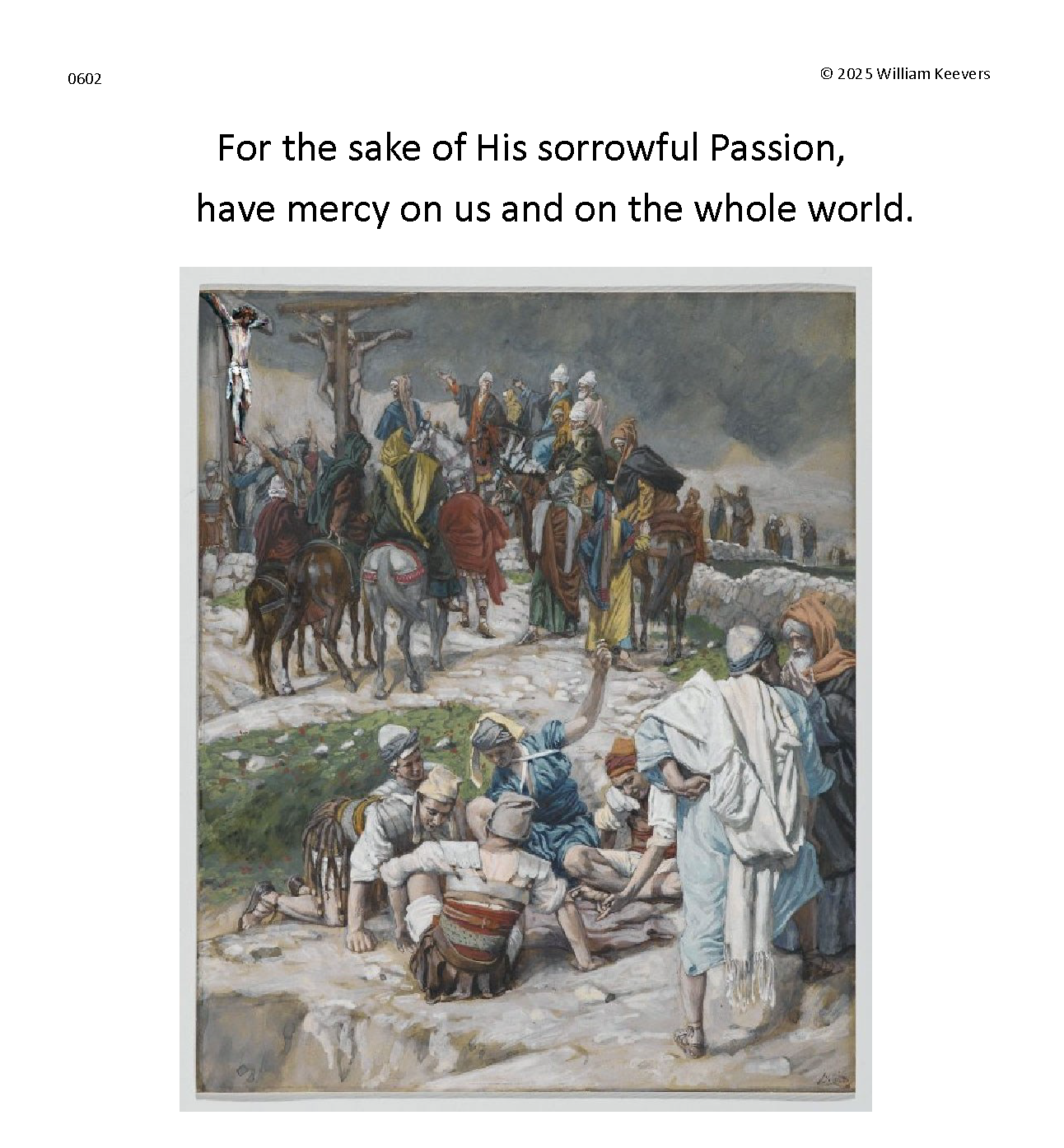

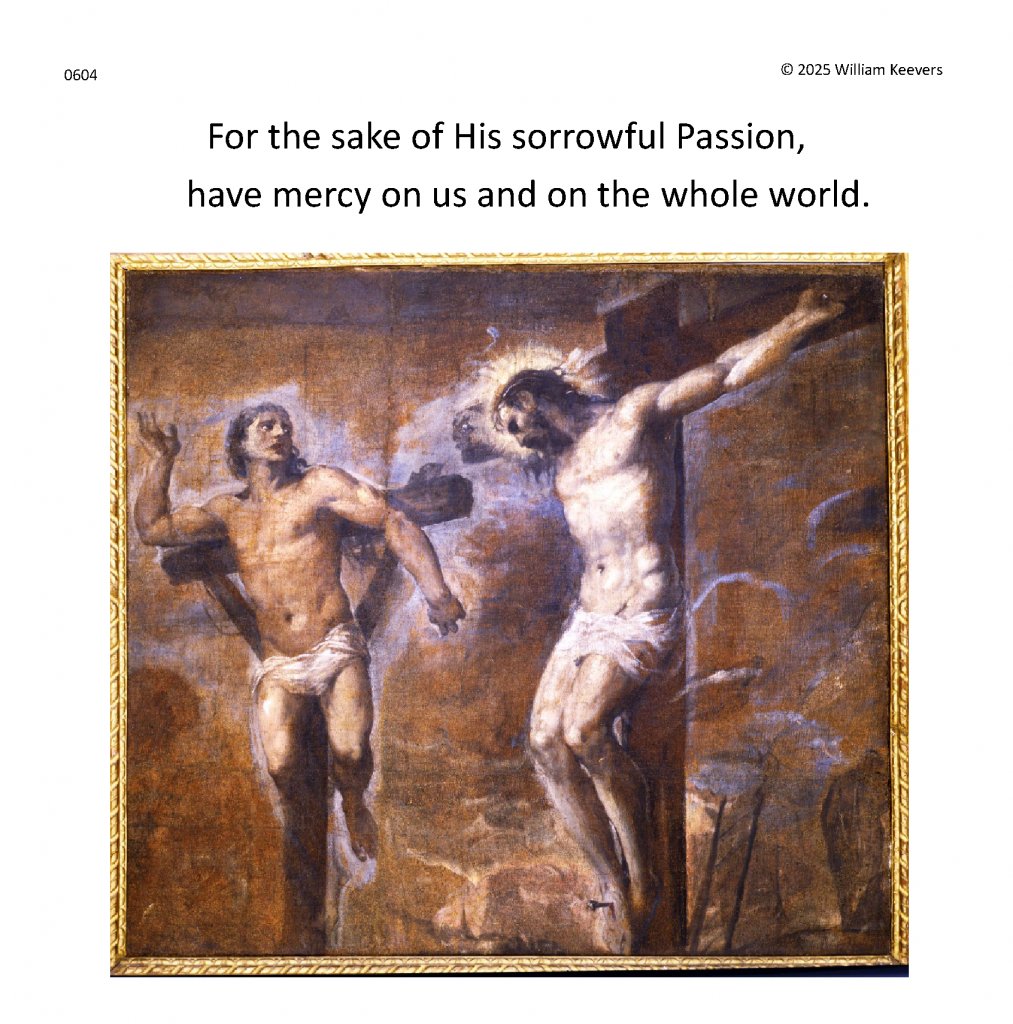
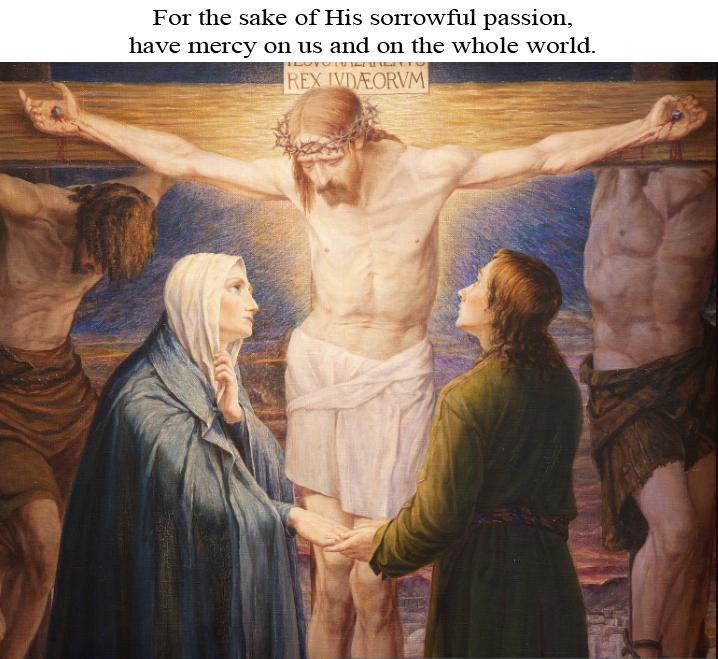
And the dragon was angry against the woman: and went to make war with the rest of her seed, who keep the commandments of God, and have the testimony of Jesus Christ. – Revelation 12:17
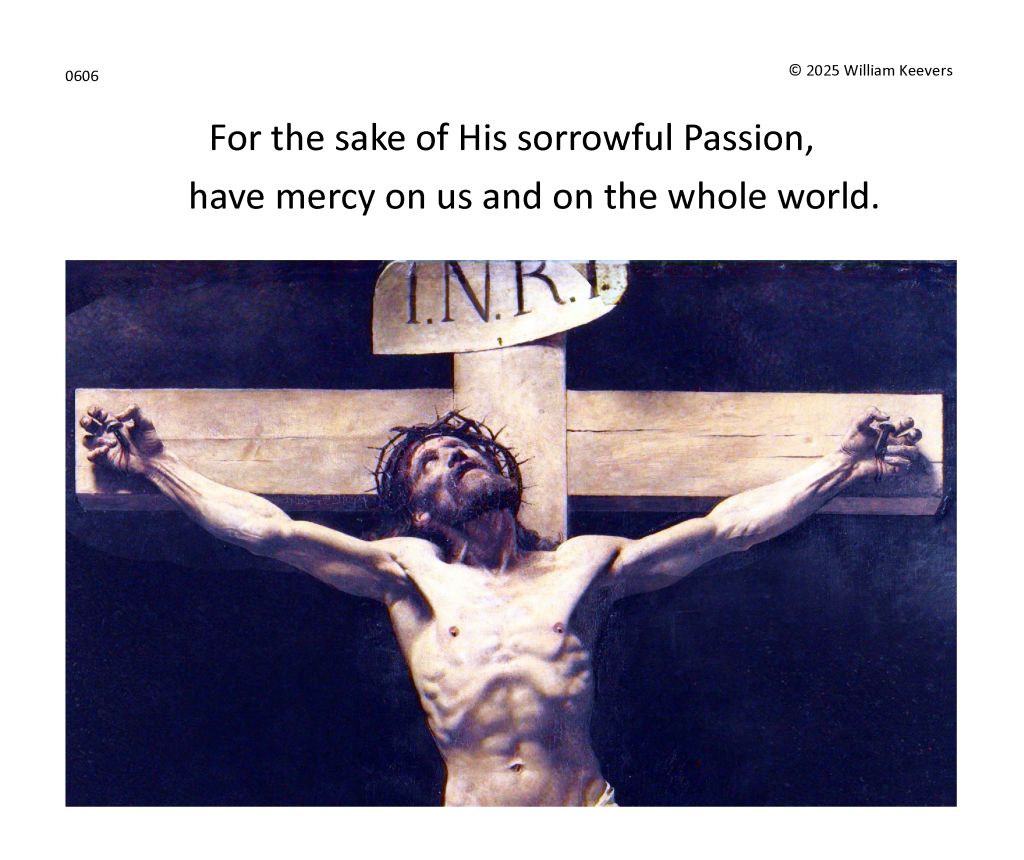
Jesus was abandoned in His passion in order that we might not remain abandoned in the sins which we have committed.
0607
For the sake of His sorrowful passion,
have mercy on us, and on the whole world.
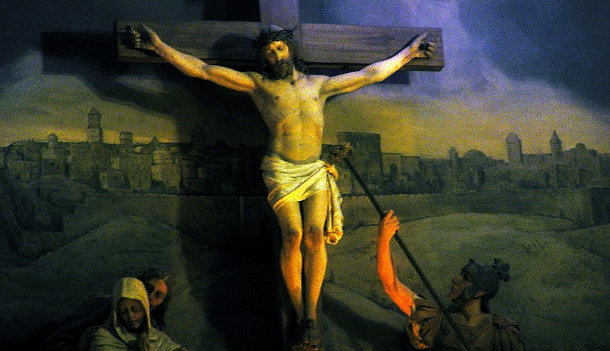
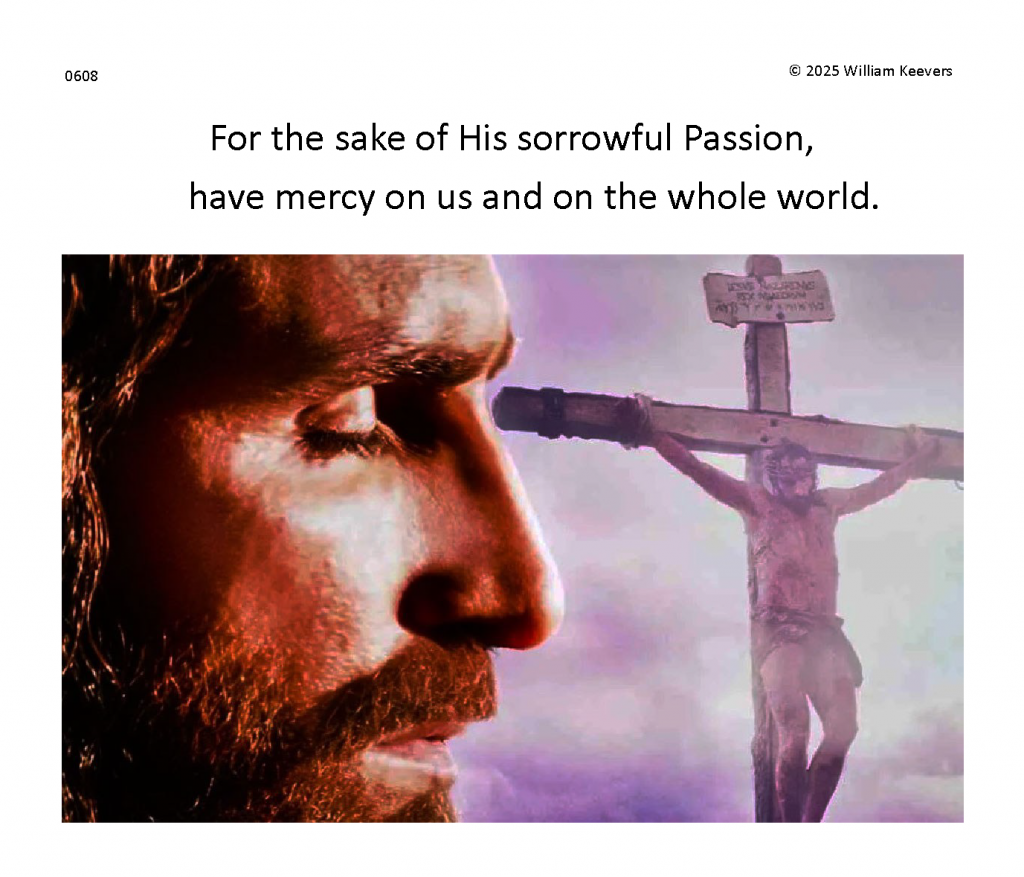
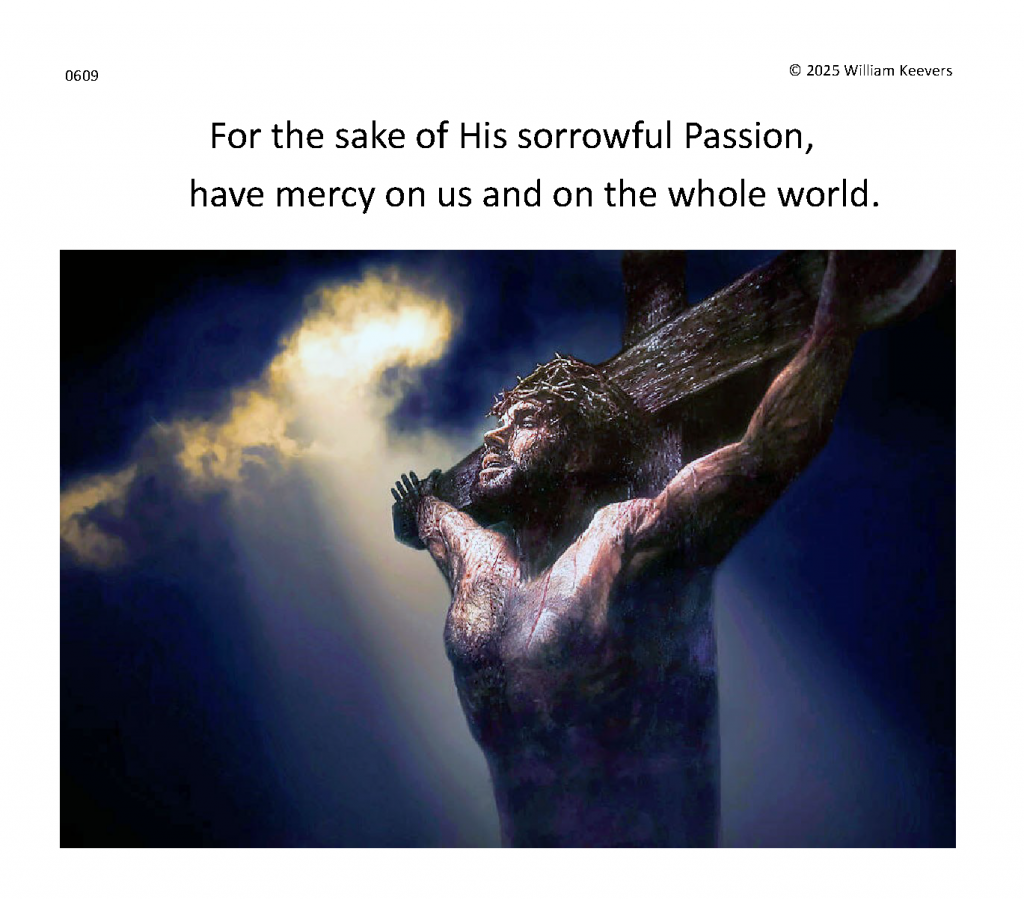

To audition background music for the Ending Prayers of The Chaplet of the Divine Mercy, click the ▶ button to listen to an organ setting of the composition Ave Verum Corpus by the late Romantic English composer Edward Elgar (1857-1954), or play the music in a New Window ⧉
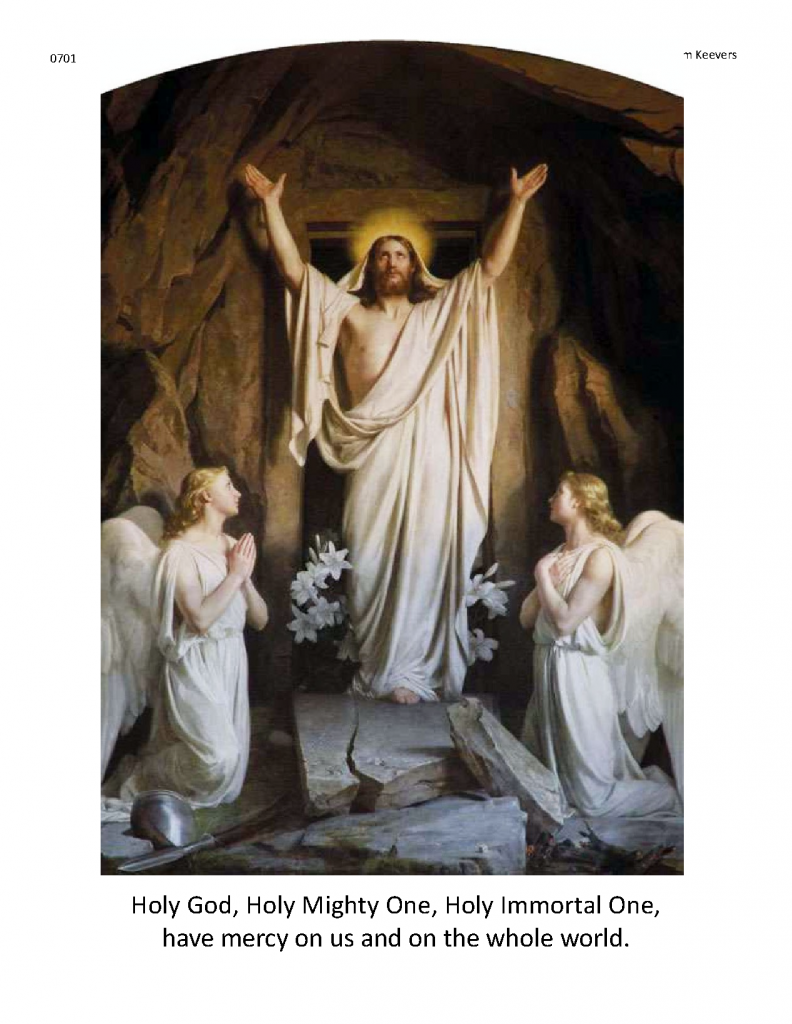
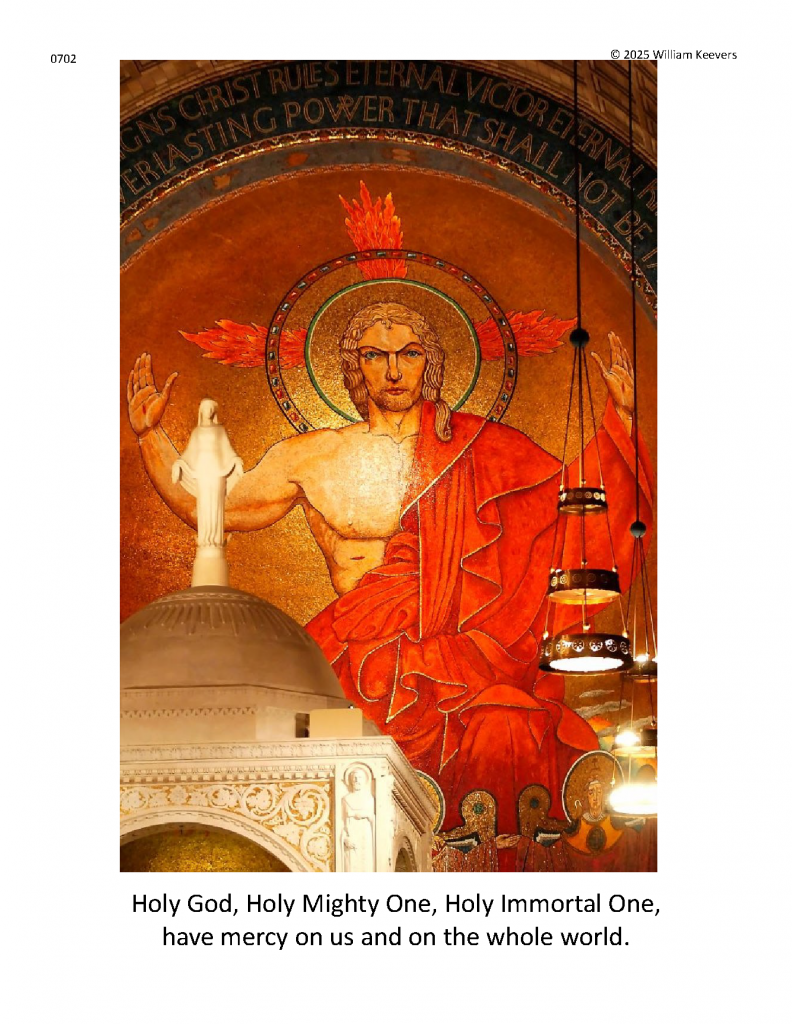
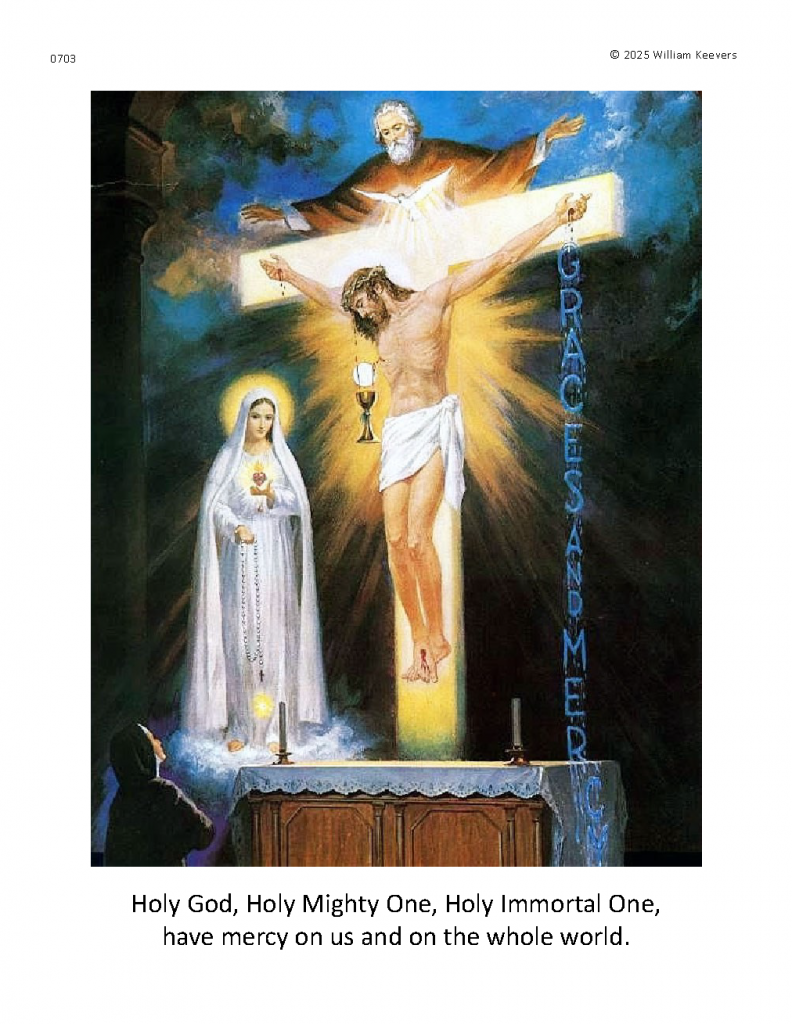


May the most holy, most sacred, most adorable, most incomprehensible and ineffable Name of God be forever praised, blessed, loved, adored and glorified in heaven, on earth, and under the earth by all the creatures of God and by the Sacred Heart of Our Lord Jesus Christ in the Most Holy Sacrament of the Altar.
How do the several main Traditional Catholic groups, the SSPX, the FSSP and ICKSP regard the orthodoxy of The Chaplet of the Divine Mercy?
There is variation among Traditional Catholic groups, and it hinges on both their general approach to private revelation and their attitude toward the post–Vatican II liturgical landscape.
1. SSPX (Society of St. Pius X)
-
Official stance: The SSPX has historically been critical of the Divine Mercy devotion and chaplet. Their critique is not just about liturgical novelty, but also about the theological underpinnings of St. Faustina Kowalska’s diary.
-
Concerns include:
-
Ambiguous language about God’s mercy (they argue it risks minimizing God’s justice).
-
The association with John Paul II, who canonized Faustina and promoted the devotion, which the SSPX often interprets in the broader context of post-conciliar innovations.
-
The earlier 1959 prohibition (the Holy Office initially forbade public propagation of the devotion due to translation and theological concerns; this ban was lifted in 1978). The SSPX tends to point back to the fact that serious doubts once existed at the Vatican level.
-
-
Summary: The SSPX does not promote the Chaplet of Divine Mercy and often warns the faithful against it, preferring traditional devotions such as the Rosary, Sacred Heart, and traditional Stations of the Cross.
2. FSSP (Priestly Fraternity of St. Peter)
-
Official stance: The FSSP, being in full canonical union with Rome and generally deferential to papal guidance, accepts the Chaplet of Divine Mercy as orthodox and legitimate.
-
Practice: Many FSSP parishes may not emphasize it as much as the Rosary or traditional devotions, but they do not oppose it. Individual priests sometimes lead Divine Mercy devotions, especially around Divine Mercy Sunday.
-
Summary: Seen as an approved, orthodox devotion, but not at the center of their apostolate.
3. ICKSP (Institute of Christ the King Sovereign Priest)
-
Official stance: Like the FSSP, the ICKSP is fully regularized under Rome and does not oppose the Chaplet of Divine Mercy.
-
Practice: Their spirituality is heavily oriented to the Sacred Heart, Christ the King, and liturgical solemnity, so the Chaplet of Divine Mercy is not a major emphasis. However, it is not excluded or regarded as heterodox.
-
Summary: Accepted as orthodox, but not as central as older, “classic” devotions.
Overall picture
-
SSPX: Skeptical, critical, discourages it.
-
FSSP & ICKSP: Accept its orthodoxy, do not oppose it, but usually emphasize older traditional devotions.
